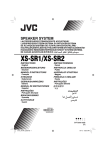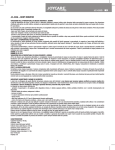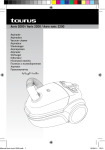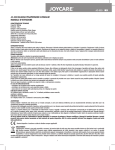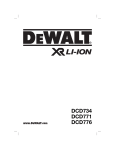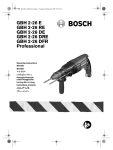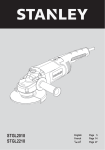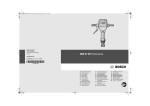Download DEWALT D25721K Use and Care Manual
Transcript
D25721 D25723 D25871 English (original instructions) 5 Français (traduction de la notice d’instructions originale) 13 )ﺓﻱﻝﺹﺃﻝﺍ ﺕﺍﻡﻱﻝﻉﺕﻝﺍ ﻥﻉ ﻡﺝﺭﺕﻡ( ﺓﻱﺏﺭﻉﻝﺍ 22 Copyright DEWALT 2 Figure 1 1 ﺷﻜﻞ e f o l d w a t b i g h e c f D25721/D25723 c o l w f e d D25871 a g p e 1 Figure 2A n l 2A ﺷﻜﻞ j k m o i h c Figure 2B 2B ﺷﻜﻞ c y j p 2 Figure 3 3 ﺷﻜﻞ D25723 D25721 u v t g g s s r r D25871 g s r 3 Figure 4A Figure 5 4A ﺷﻜﻞ 5 ﺷﻜﻞ f Figure 4B 4B ﺷﻜﻞ Figure 6 d 6 ﺷﻜﻞ D25721/D25723 D25871 c d c 4 E NG L I S H SDS MAX ® COMBINATION & CHIPPING HAMMERS D25721, D25723, D25871 Denotes risk of electric shock. Congratulations! You have chosen a DEWALT tool. Years of experience, thorough product development and innovation make DEWALT one of the most reliable partners for professional power tool users. Technical Data Voltage V D25721 D25723 D25871 220–240 220–240 220–240 120 120 120 1 1 1 1350 1400 1400 Type Power input W Impact energy (EPTA 05/2009) J 1.5–11 1.5–11 1.5–11 Total drilling range in concrete: solid bits mm 12–48 12–48 – core bits mm 40–115 40–125 – Optimum drilling range in concrete: solid bits mm 25–40 25–45 – Chisel positions 24 24 24 Tool holder SDS Max® SDS Max® SDS Max® Weight kg 8.7 9.1 8.0 Definitions: Safety Guidelines The definitions below describe the level of severity for each signal word. Please read the manual and pay attention to these symbols. DANGER: Indicates an imminently hazardous situation which, if not avoided, will result in death or serious injury. WARNING: Indicates a potentially hazardous situation which, if not avoided, could result in death or serious injury. CAUTION: Indicates a potentially hazardous situation which, if not avoided, may result in minor or moderate injury. NOTICE: Indicates a practice not related to personal injury which, if not avoided, may result in property damage. Denotes risk of fire. WARNING: To reduce the risk of injury, read the instruction manual. General Power Tool Safety Warnings WARNING! Read all safety warnings and all instructions. Failure to follow the warnings and instructions may result in electric shock, fire and/or serious injury. SAVE ALL WARNINGS AND INSTRUCTIONS FOR FUTURE REFERENCE The term “power tool” in the warnings refers to your mains-operated (corded) power tool or batteryoperated (cordless) power tool. 1) WORK AREA SAFETY a) Keep work area clean and well lit. Cluttered or dark areas invite accidents. b) Do not operate power tools in explosive atmospheres, such as in the presence of flammable liquids, gases or dust. Power tools create sparks which may ignite the dust or fumes. c) Keep children and bystanders away while operating a power tool. Distractions can cause you to lose control. 2) ELECTRICAL SAFETY a) Power tool plugs must match the outlet. Never modify the plug in any way. Do not use any adapter plugs with earthed (grounded) power tools. Unmodified plugs and matching outlets will reduce risk of electric shock. b) Avoid body contact with earthed or grounded surfaces such as pipes, radiators, ranges and refrigerators. There is an increased risk of electric shock if your body is earthed or grounded. c) Do not expose power tools to rain or wet conditions. Water entering a power tool will increase the risk of electric shock. d) Do not abuse the cord. Never use the cord for carrying, pulling or unplugging the power tool. Keep cord away from heat, oil, sharp edges or moving parts. 5 EN GLI S H e) f) Damaged or entangled cords increase the risk of electric shock. When operating a power tool outdoors, use an extension cord suitable for outdoor use. Use of a cord suitable for outdoor use reduces the risk of electric shock. If operating a power tool in a damp location is unavoidable, use a residual current device (RCD) protected supply. Use of an RCD reduces the risk of electric shock. 3) PERSONAL SAFETY a) Stay alert, watch what you are doing and use common sense when operating a power tool. Do not use a power tool while you are tired or under the influence of drugs, alcohol or medication. A moment of inattention while operating power tools may result in serious personal injury. b) Use personal protective equipment. Always wear eye protection. Protective equipment such as dust mask, non-skid safety shoes, hard hat, or hearing protection used for appropriate conditions will reduce personal injuries. c) Prevent unintentional starting. Ensure the switch is in the off position before connecting to power source and/or battery pack, picking up or carrying the tool. Carrying power tools with your finger on the switch or energising power tools that have the switch on invites accidents. d) Remove any adjusting key or wrench before turning the power tool on. A wrench or a key left attached to a rotating part of the power tool may result in personal injury. e) Do not overreach. Keep proper footing and balance at all times. This enables better control of the power tool in unexpected situations. f) Dress properly. Do not wear loose clothing or jewellery. Keep your hair, clothing and gloves away from moving parts. Loose clothes, jewellery or long hair can be caught in moving parts. g) If devices are provided for the connection of dust extraction and collection facilities, ensure these are connected and properly used. Use of dust collection can reduce dust-related hazards. 4) POWER TOOL USE AND CARE a) Do not force the power tool. Use the correct power tool for your application. The correct power tool will do the job better and safer at the rate for which it was designed. 6 b) c) d) e) f) g) Do not use the power tool if the switch does not turn it on and off. Any power tool that cannot be controlled with the switch is dangerous and must be repaired. Disconnect the plug from the power source and/or the battery pack from the power tool before making any adjustments, changing accessories, or storing power tools. Such preventive safety measures reduce the risk of starting the power tool accidentally. Store idle power tools out of the reach of children and do not allow persons unfamiliar with the power tool or these instructions to operate the power tool. Power tools are dangerous in the hands of untrained users. Maintain power tools. Check for misalignment or binding of moving parts, breakage of parts and any other condition that may affect the power tool’s operation. If damaged, have the power tool repaired before use. Many accidents are caused by poorly maintained power tools. Keep cutting tools sharp and clean. Properly maintained cutting tools with sharp cutting edges are less likely to bind and are easier to control. Use the power tool, accessories and tool bits etc., in accordance with these instructions taking into account the working conditions and the work to be performed. Use of the power tool for operations different from those intended could result in a hazardous situation. 5) SERVICE a) Have your power tool serviced by a qualified repair person using only identical replacement parts. This will ensure that the safety of the power tool is maintained. Additional Safety Instructions for Rotary Hammers • Wear ear protectors. Exposure to noise can cause hearing loss. • Use auxiliary handle(s), if supplied with the tool. Loss of control can cause personal injury. • Hold power tool by insulated gripping surfaces, when performing an operation where the cutting accessory may contact hidden wiring or its own cord. Cutting accessory contacting a “live” wire may make exposed metal parts of the power tool “live” and could give the operator an electric shock. E NG L I S H Residual Risks Package Contents The following risks are inherent to the use of rotary and chipping hammers: The package contains: – Injuries caused by touching the rotating parts or hot parts of the tool In spite of the application of the relevant safety regulations and the implementation of safety devices, certain residual risks cannot be avoided. These are: 1 Rotary hammer (D25721, D25723) or 1 Chipping Hammer (D25871) 1 Side handle 1 Kitbox (K-models only) – Impairment of hearing. 1 Pointed chisel (only D25871) – Risk of squeezing fingers when changing the accessory. 1 Instruction manual – Health hazards caused by breathing dust developed when working in concrete and/or masonry. • Check for damage to the tool, parts or accessories which may have occurred during transport. Markings on Tool The following pictograms are shown on the tool: Read instruction manual before use. 1 Exploded drawing • Take the time to thoroughly read and understand this manual prior to operation. Description (fig. 1, 2A, 2B) WARNING: Never modify the power tool or any part of it. Damage or personal injury could result. Wear ear protection. a. Trigger switch (D25721, D25723) Wear eye protection. On/off rocker switch (D25871) b. Lock-on slider (D25721, D25723) c. Side handle Clutch Setting 40 Nm is designed for most drilling applications. d. Main handle Clutch Setting 80 Nm is designed for higher torque applications. g. Electronic speed and impact control dial e. Active vibration control f. Mode selector switch h. Clamp wheel Red service indicator LED. For detailed description see under Service Indicator LED’s. Yellow service indicator LED. For detailed description see under Service Indicator LED’s. i. Side handle clamp j. Steel ring k. Bush l. Tool holder m. Pin n. Collar o. Locking sleeve DATE CODE POSITION (FIG. 1) The Date Code (w), which also includes the year of manufacture, is printed into the housing. Example: 2013 XX XX Year of Manufacture p. Side handle knob INTENDED USE D25721, D25723 Your rotary hammer has been designed for professional rotary drilling and chipping applications. 7 EN GLI S H D25871 Your chipping hammer has been designed for professional chipping, chiselling and demolition applications. DO NOT use under wet conditions or in presence of flammable liquids or gases. These hammers are professional power tools. DO NOT let children come into contact with the tool. Supervision is required when inexperienced operators use this tool. • This product is not intended for use by persons (including children) suffering from diminished physical, sensory or mental abilities; lack of experience, knowledge or skills unless they are supervised by a person responsible for their safety. Children should never be left alone with this product. Soft Start Feature D25723 The soft start feature allows the tool to accelerate slowly, thus preventing the drill bit from walking off the intended hole position when starting. The soft start feature also reduces the immediate torque reaction transmitted to the gearing and the operator if the hammer is started with the drill bit in an existing hole. Electronic Speed and Impact Control (fig. 1, 3) The electronic speed and impact control (g) offers the following advantages: In addition to the two-stage mechanical clutch, Ultimate Torque Control (UTC) offers increased user comfort and safety through an on-board, anti-rotation technology capable of detecting if the user loses control of the hammer. When a jam is detected, the torque and speed are reduced instantly. This feature prevents self rotation of the tool reducing the occurrence of wrist injuries. Service Indicator LEDs (fig. 3) The yellow brushwear indicator LED (s) lights up when the carbon brushes are nearly worn out to indicate that the tool needs servicing within the next 8 hours of use. D25721, D25723 The red service indicator LED (r) lights up if the lock-on button (b) is used in any mode except the chipping mode. On models fitted with Ultimate Torque Control (UTC), the red LED indicator (r) lights up if the anti-rotational device is activated. The red indicator starts to flash if there is a fault with the tool or the brushes have completely worn out (refer to Brushes under Maintenance). D25871 The red service indicator LED (r) lights up if there is a fault with the tool or the brushes have completely worn out (refer to Brushes under Maintenance). Fully Vibration-dampened Main Handle (fig. 1) – use of smaller accessories without risk of breakage; The dampers in the main handle (d) absorb the vibrations transmitted to the user. This improves user comfort during the operation. – minimised break-out when chiselling or drilling in soft or brittle materials; Electrical Safety – optimal tool control for precise chiselling. Torque Limiting Clutch WARNING: The user must always maintain a firm grip on the tool when in operation. The torque limiting clutch reduces the maximum torque reaction transmitted to the operator in case of jamming of a drill bit. This feature also prevents the gearing and electric motor from stalling. NOTICE: Always turn the tool off before changing torque control settings or damage to tool may result. 8 ULTIMATE TORQUE CONTROL (UTC) D25723 The electric motor has been designed for one voltage only. Always check that the power supply corresponds to the voltage on the rating plate. Your DEWALT tool is double insulated in accordance with EN 60745; therefore no earth wire is required. WARNING: 120 V units have to be operated via a fail-safe isolating transformer with an earth screen between the primary and secondary winding. If the supply cord is damaged, it must be replaced by a specially prepared cord available through the DEWALT service organisation. E NG L I S H Mains Plug Replacement (Middle East and Africa) If a new mains plug needs to be fitted: • Safely dispose of the old plug. • Connect the brown lead to the live terminal in the plug. • Connect the blue lead to the neutral terminal. WARNING: No connection is to be made to the earth terminal. Follow the fitting instructions supplied with good quality plugs. Recommended fuse: 13 A. Using an Extension Cable If an extension cable is required, use an approved extension cable suitable for the power input of this tool (see Technical Data). The minimum conductor size is 1 mm2; the maximum length is 30 m. When using a cable reel, always unwind the cable completely. ASSEMBLY AND ADJUSTMENTS WARNING: To reduce the risk of injury, turn unit off and disconnect machine from power source before installing and removing accessories, before adjusting or changing setups or when making repairs. Be sure the trigger switch is in the OFF position. An accidental start-up can cause injury. WARNING: Tool bits may be hot and gloves should be worn when changing or removing them to avoid personal injury. Assembling and Fitting the Side Handle (fig. 2A, 2B) The side handle (c) can be mounted on either side of the machine to suit both right- and left-handed users. WARNING: Always operate the tool with the side handle properly assembled. D25721, D25723 MOUNTING IN FRONT POSITION (FIG. 2A) 1. Snap the steel ring (j) over the collar (n) behind the tool holder (l). Squeeze both ends together, mount the bush (k) and insert the pin (m). WARNING: Once assembled, the side handle clamp should never be removed. 3. Screw the side handle (c) into the bush (k) and then into clamp wheel. Tighten securely. 4. Rotate the side handle mounting assembly to the desired position. For drilling horizontally with a heavy drill bit, we recommend to place the side handle at an angle of approximately 20° for optimum control. 5. Lock the side handle mounting assembly in place by tightening the clamp wheel (h). D25871 (FIG. 2B) 1. Unscrew the side handle knob (p). 2. Slide the side handle assembly onto the machine locating the steel ring (j) in the mounting area (y). The correct position of the side handle is between head and middle of the tube. 3. Adjust the side handle (c) to the desired angle. 4. Slide and rotate the side handle to the desired position. 5. Lock the side handle in place by tightening the knob (p). Inserting and Removing SDS Max® Accessories (fig. 1, 4A, 4B) This machine uses SDS Max® bits and chisels (refer to the inset in figure 4B for a cross-section of an SDS Max® bit shank). 1. Clean the bit shank. 2. Pull back the locking sleeve (o) and insert the bit shank. 3. Turn the bit slightly until the sleeve snaps into position. 4. Pull on the bit to check if it is properly locked. The hammering function requires the bit to be able to move axially several centimetres when locked in the tool holder. 5. To remove a bit pull back the tool holder locking sleeve/collar (o) and pull the bit out of the tool holder (l). Selecting the Operating Mode (fig. 1) Hammerdrilling: D25721, D25723 for concrete, brick, stone and masonry drilling operations. 2. Place the side handle clamp (i) and screw on the clamp wheel (h). Do not tighten. 9 EN GLI S H Hammering only: for chiselling and demolition applications. In this mode the tool can also be used as a lever to free a jammed drill bit. 1. To select the operating mode, rotate the mode selector switch (f) until it points to the symbol of the required mode. It may be neccessary to twist the tool holder (l) slightly to allow the mode selector switch (f) to pass the position. 2. Check that the mode selector switch (f) is locked in place. Indexing the Chisel Position (fig. 5) The chisel can be indexed and locked into 24 different positions. 1. Rotate the mode selector switch (f) until it points towards the position. 2. Rotate the chisel in the desired position. 3. Set the mode selector switch (f) to the “hammering only” position. 4. Twist the chisel until it locks in position. Setting the Electronic Speed and Impact Control Dial (fig. 1, 3) Turn the dial (g) to the desired level. Turn the dial upwards for higher speed and downwards for lower speed. The required setting is a matter of experience, e.g. – when chiselling or drilling in soft, brittle materials or when minimum break-out is required, set the dial to a low setting; – when breaking or drilling in harder materials, set the dial to a high setting. Setting the Two Stage Mechanical Clutch (fig. 3) D25723 NOTICE: Always turn the tool off before changing torque control settings or damage to the tool may result. Move the torque control lever (t) to setting 40 Nm or 80 Nm as needed for application. • Clutch Setting 40 Nm (u) is designed for most drilling applications and is designed to easily clutch out when the drill bit encounters re-bar or other foreign substances. 10 • Clutch Setting 80 Nm (v) is designed for higher torque applications such as core-bits and deep hole drilling and is designed to clutch out at a higher torque threshold. NOTE: If it is not possible to select position 80 Nm run the unit under load and try again. Each time the tool is plugged in, it will automatically default to clutch setting 1 into clutch setting 40 Nm (u), the most sensitive setting. OPERATION Instructions for Use WARNING: Always observe the safety instructions and applicable regulations. WARNING: To reduce the risk of injury, turn unit off and disconnect machine from power source before installing and removing accessories, before adjusting or changing setups or when making repairs. Be sure the trigger switch is in the OFF position. An accidental start-up can cause injury. WARNING: Tool bits may be hot and gloves should be worn when changing or removing them to avoid personal injury. WARNING: • Be aware of the location of pipework and wiring. • Apply only a gentle pressure to the tool (approximately 20 kg). Excessive force does not speed up drilling but decreases tool performance and may shorten tool life. • Always hold the tool firmly with both hands and ensure a secure stance. Always operate the tool with the side handle properly assembled. NOTE: Operating temperature is -7˚ to +40˚ C (19˚ to 104˚ F). Using the tool outside of this temperature range will decrease the life of the tool. Proper Hand Position (fig. 6) WARNING: To reduce the risk of serious personal injury, ALWAYS use proper hand position as shown. WARNING: To reduce the risk of serious personal injury, ALWAYS hold securely in anticipation of a sudden reaction. E NG L I S H Proper hand position requires one hand on the side handle (c), with the other hand on the main handle (d). Switching On and Off (fig. 1) D25721, D25723 To turn the tool on, depress the trigger switch (a). To stop the tool, release the trigger switch. D25721, D25723 The lock-on slider (b) allows the trigger switch (a) to be locked on in chiselling mode only. If the lock-on button is activated in drilling mode, as a feature the tool will switch off automatically. To turn the tool on, press the trigger switch (a). To stop the tool, release the switch. For continuous operation, press and hold down the switch (a), slide the lock-on button (b) upwards and release the switch. To stop the tool in continuous operation, press the switch briefly and release it. Always switch off the tool when work is finished and before unplugging. D25871 3. Set the mode selector switch (f) to the hammerdrilling position. 4. Turn the electronic speed and impact control dial (g) to a medium or high speed setting. 5. Fit and adjust the side handle (c). 6. Place the centerdrill on the spot and switch on the tool. Drill until the core penetrates into the concrete approximately 1 cm. 7. Stop the tool and remove the centerdrill. Place the core bit back into the hole and continue drilling. 8. When drilling through a structure thicker than the depth of the core bit, break away the round cylinder of concrete or core inside the bit at regular intervals. To avoid unwanted breaking away of concrete around the hole, first drill a hole the diameter of the centerdrill completely through the structure. Then drill the cored hole halfway from each side. 9. Always turn the tool off when work is finished and before unplugging. Chipping and Chiselling (fig. 1) To turn the tool on, press the on/off rocker switch (a) at the lower part of the trigger. 1. Insert the appropriate chisel and rotate it by hand to lock it into one of 24 positions. To stop the tool, press the on/ off rocker switch at the upper part of the trigger. 2. Set the mode selector switch (f) to the hammering only position. Hammerdrilling 3. Set the electronic speed and impact control dial (g). To turn the tool on, press the on/off switch (a). 4. Fit and adjust the side handle (c). To stop the tool, release the switch. 5. Turn the tool on and start working. Drilling with a Solid Bit (fig. 1) 6. Always turn the tool off when work is finished and before unplugging. D25721, D25723 1. Insert the appropriate drill bit. MAINTENANCE 2. Set the mode selector switch (f) to the hammerdrilling position. Your DEWALT power tool has been designed to operate over a long period of time with a minimum of maintenance. Continuous satisfactory operation depends upon proper tool care and regular cleaning. 3. Set the electronic speed and impact control dial (g). 6. Place the drill bit on the spot and switch on the tool. This machine is not user-serviceable. Take the tool to an authorised DEWALT repair agent after approximately 150 hours of use. If problems occur before this time, contact an authorised DEWALT repair agent. 7. Always switch off the tool when work is finished and before unplugging. Brushes (fig. 3) 4. Fit and adjust the side handle (c). 5. Mark the spot where the hole is to be drilled. Drilling with a Core Bit (fig. 1) The carbon brushes are not user-serviceable. Take the tool to an authorized DEWALT repair agent. 1. Insert the appropriate core bit. 2. Assemble the centerdrill into the core bit. 11 EN GLI S H The yellow brushwear indicator LED (s) lights up when the carbon brushes are nearly worn out. After a further 8 hours of use or after the brushes have completely worn out, the motor will automatically be shut offf. Tool maintenance needs to be carried out as soon as the service indicator (r) lights up. Lubrication Your power tool requires no additional lubrication. Cleaning WARNING: Blow dirt and dust out of the main housing with dry air as often as dirt is seen collecting in and around the air vents. Wear approved eye protection and approved dust mask when performing this procedure. WARNING: Never use solvents or other harsh chemicals for cleaning the non-metallic parts of the tool. These chemicals may weaken the materials used in these parts. Use a cloth dampened only with water and mild soap. Never let any liquid get inside the tool; never immerse any part of the tool into a liquid. Optional Accessories WARNING: Since accessories, other than those offered by DEWALT, have not been tested with this product, use of such accessories with this tool could be hazardous. To reduce the risk of injury, only DEWALT recommended accessories should be used with this product. Consult your dealer for further information on the appropriate accessories. Various types of SDS Max® drill bits and chisels are available as an option. Protecting the Environment Separate collection. This product must not be disposed of with normal household waste. 12 Should you find one day that your DEWALT product needs replacement, or if it is of no further use to you, do not dispose of it with household waste. Make this product available for separate collection. Separate collection of used products and packaging allows materials to be recycled and used again. Re-use of recycled materials helps prevent environmental pollution and reduces the demand for raw materials. Local regulations may provide for separate collection of electrical products from the household, at municipal waste sites or by the retailer when you purchase a new product. DEWALT provides a facility for the collection and recycling of DEWALT products once they have reached the end of their working life. To take advantage of this service please return your product to any authorised repair agent who will collect them on our behalf. You can check the location of your nearest authorised repair agent by contacting your local DEWALT office at the address indicated in this manual. Alternatively, a list of authorised DEWALT repair agents and full details of our after-sales service and contacts are available on the Internet at: www.2helpU.com. FRANÇAIS MARTILLOS SDS MÁX® COMBINACIÓN Y MARTILLOS DE SOLDADOR D25721, D25723, D25871 Félicitations ! Vous avez choisi un outil DEWALT. Des années d’expertise dans le développement et l’innovation de ses produits ont fait de DEWALT, le partenaire privilégié des utilisateurs professionnels d’outils électriques. Caractéristiques techniques Voltaje D25721 D25723 D25871 VDC 220–240 220–240 220–240 120 120 120 1 1 1 W 1350 1400 1400 Tipo Potencia absorbida Energía de impacto (EPTA 05/2009) J 1,5–11 1,5–11 1,5–11 Capacidad de perforación total en hormigón: brocas sólidas mm 12–48 12–48 – barrenas cilíndricas huecas mm 40–115 40-125 – Capacidad de perforación óptima en hormigón: brocas sólidas mm 25–40 25–45 – Posiciones del cincel 24 24 24 Portaherramientas SDS Max® SDS Max® SDS Max® Peso kg 8,7 9,1 8,0 Définitions : consignes de sécurité Les définitions ci-après décrivent le degré de risques associé à chaque balise. Lire soigneusement la notice d’instructions et respecter ces symboles. DANGER : indique une situation de danger imminent qui, si rien n’est fait pour l’éviter, aura comme conséquences la mort ou des dommages corporels graves. AVERTISSEMENT : indique une situation de danger potentiel qui, si rien n’est fait pour l’éviter, pourra avoir comme conséquences la mort ou des dommages corporels graves. ATTENTION : indique une situation de danger potentiel qui, si rien n’est fait pour l’éviter, pourrait avoir comme conséquences des dommages corporels mineurs ou moindres. AVIS : indique une pratique ne posant aucun risque de dommages corporels, mais qui par contre, si rien n’est fait pour l’éviter, pourrait poser des risques de dommages matériels. Indique des risques de décharges électriques. Indique des risques d’incendie. AVERTISSEMENT : pour réduire tout risque de dommages corporels, lire la notice d’instructions Consignes de sécurité générales propres aux outils électriques AVERTISSEMENT ! lire toutes les directives et consignes de sécurité. Tout manquement aux directives et consignes ci-incluses comporte des risques de décharges électriques, d’incendie et/ou de dommages corporels graves. CONSERVER TOUTES CES DIRECTIVES ET CONSIGNES À TITRE DE RÉFÉRENCE Le terme « outil électrique » mentionné dans les avertissements ci-après se rapporte aux outils alimentés sur secteur (avec fil) ou par piles (sans fil). 1) SÉCURITÉ – AIRE DE TRAVAIL a) Maintenir l’aire de travail propre et bien éclairée. Les lieux sombres ou encombrés sont propices aux accidents. b) Ne pas utiliser un outil électrique dans un milieu déflagrant, comme en présence de liquides, gaz ou poussières inflammables. Les outils électriques peuvent produire des étincelles qui pourraient enflammer toute émanation ou poussière ambiante. c) Maintenir à l’écart les enfants, ou toute autre personne, lors de l’utilisation d’un outil électrique. Toute distraction pourrait faire perdre la maîtrise de l’appareil. 2) SÉCURITÉ – ÉLECTRICITÉ a) La fiche électrique de l’outil doit correspondre à la prise murale. Ne modifier la fiche en aucune façon. Ne pas utiliser de fiche d’adaptation avec un outil électrique mis à la terre (masse). 13 FRANÇAIS b) c) d) e) f) L’utilisation de fiches d’origine et de prises appropriées réduira tout risque de décharges électriques. Éviter tout contact corporel avec des éléments mis à la terre comme : tuyaux, radiateurs, cuisinières ou réfrigérateurs. Les risques de décharges électriques augmentent lorsque le corps est mis à la terre. Ne pas exposer les outils électriques à la pluie ou à l’humidité. Tout contact d’un outil électrique avec un liquide augmente les risques de décharges électriques. Ne pas utiliser le cordon de façon abusive. Ne jamais utiliser le cordon pour transporter, tirer ou débrancher un outil électrique. Protéger le cordon de toute source de chaleur, de l’huile, et de tout bord tranchant ou pièce mobile. Les cordons endommagés ou emmêlés augmentent les risques de décharges électriques. En cas d’utilisation d’un outil électrique à l’extérieur, utiliser systématiquement une rallonge conçue à cet effet. Cela diminuera tout risque de décharges électriques. Si on ne peut éviter d’utiliser un outil électrique en milieu humide, utiliser un circuit protégé par un dispositif de courant résiduel (RCD). Cela réduira tout risque de décharges électriques. 3) SÉCURITÉ INDIVIDUELLE a) Rester systématiquement vigilant et faire preuve de jugement lorsqu’on utilise un outil électrique. Ne pas utiliser d’outil électrique en cas de fatigue ou sous l’influence de drogues, d’alcool ou de médicaments. Tout moment d’inattention pendant l’utilisation d’un outil électrique comporte des risques de dommages corporels graves. b) Porter un équipement de protection individuel. Porter systématiquement un dispositif de protection oculaire. Le fait de porter un masque anti-poussières, des chaussures antidérapantes, un casque de sécurité ou un dispositif de protection auditive, lorsque la situation le requiert, réduira les risques de dommages corporels. c) Prévenir tout démarrage accidentel. S’assurer que l’interrupteur est en position d’arrêt avant de brancher l’outil sur le secteur et/ou à la batterie, ou de le ramasser ou le transporter. Transporter un outil le doigt sur l’interrupteur ou brancher un 14 d) e) f) g) outil électrique alors que l’interrupteur est en position de marche invite les accidents. Retirer toute clé de réglage avant de démarrer l’outil. Une clé laissée sur une pièce rotative d’un outil électrique comporte des risques de dommages corporels. Adopter une position stable. Maintenir les pieds bien ancrés au sol et conserver son équilibre en permanence. Cela permettra de mieux maîtriser l’outil électrique en cas de situations imprévues. Porter des vêtements appropriés. Ne porter aucun vêtement ample ou bijou. Maintenir cheveux, vêtements et gants à l’écart des pièces mobiles, car ils pourraient s’y faire prendre. Lorsqu’un dispositif de connexion à un système de dépoussiérage ou d’élimination est fourni, s’assurer qu’il est branché et utilisé correctement. L’utilisation de ces dispositifs peut réduire les risques engendrés par les poussières. 4) UTILISATION ET ENTRETIEN DES OUTILS ÉLECTRIQUES a) Ne pas forcer un outil électrique. Utiliser l’outil approprié au travail en cours. L’outil approprié effectuera un meilleur travail, de façon plus sûre et à la vitesse pour laquelle il a été conçu. b) Ne pas utiliser un outil électrique dont l’interrupteur est défectueux. Tout appareil dont l’interrupteur est défectueux est dangereux et doit être réparé. c) Débrancher la fiche du secteur et/ou la batterie de l’outil électrique avant d’effectuer tout réglage, de changer tout accessoire, ou avant de le ranger. Ces mesures préventives réduiront tout risque de démarrage accidentel de l’appareil. d) Après utilisation, ranger les outils électriques hors de portée des enfants et ne permettre à aucune personne non familière avec son fonctionnement (ou sa notice d’instructions) de l’utiliser. Les outils peuvent être dangereux entre des mains inexpérimentées. e) Entretenir les outils électriques. Vérifier les pièces mobiles pour s’assurer qu’elles sont bien alignées et tournent librement, qu’elles sont en bon état et ne sont affectées d’aucune condition susceptible de nuire au bon fonctionnement de l’outil. En cas de dommage, faire réparer l’outil électrique avant toute nouvelle utilisation. De nombreux accidents sont causés par des outils mal entretenus. FRANÇAIS f) g) Maintenir tout organe de coupe propre et bien affûté. Les outils de coupe bien entretenus et affûtés sont moins susceptibles de se coincer et sont plus faciles à contrôler. Utiliser un outil électrique, ses accessoires, mèches, etc., conformément aux présentes directives et suivant la manière prévue pour ce type particulier d’outil électrique, en tenant compte des conditions de travail et de la tâche à effectuer. L’utilisation d’un outil électrique à des fins autres que celles prévues est potentiellement dangereuse. – Riesgos para la salud causados al respirar el polvo que se produce cuando se trabaja con hormigón o mampostería. Marcas sobre la herramienta En la herramienta se muestran los siguientes pictogramas: Antes de usarse, lea el manual de instrucciones. Póngase protección para el oído. 5) RÉPARATION a) Faire entretenir les outils électriques par un réparateur qualifié en n’utilisant que des pièces de rechange identiques. Cela permettra de préserver l’intégrité de l’outil électrique et la sécurité de l’utilisateur. Póngase protección para los ojos. La configuración del embrague en 40 Nm ha sido diseñada para la mayoría de las aplicaciones de perforación. Instrucciones de seguridad adicionales para los martillos rotativos La configuración del embrague en 80 Nm ha sido diseñada para las aplicaciones con par superior. • Lleve protección acústica. La exposición ante ruidos podrá provocar una pérdida de su audición. Lea la LED del indicador de servicio. Si desea una descripción detallada, véase el apartado LED de indicador de servicio. • Utilice las asas auxiliares, si han sido suministradas con la herramienta. La pérdida de control podrá provocar daños personales. • Sostenga la herramienta eléctrica por las superficies de agarre aisladas cuando realice una operación en la que el accesorio de corte pueda estar en contacto con un cable oculto o con su propio cable. El contacto de los accesorios de corte con un cable cargado, puede cargar las partes metálicas expuestas de la herramienta eléctrica y producir una descarga eléctrica al operador. Riesgos residuales Los siguientes riesgos son inherentes al uso de los martillos rotativos y los martillos de soldador: Lea la LED del indicador de servicio amarilla. Si desea una descripción detallada, véase el apartado LED de indicador de servicio. POSICIÓN DEL CÓDIGO DE FECHA (FIG. 1) El Código de fecha (w), que contiene también el año de fabricación, viene impreso en la caja protectora. Ejemplo: 2013 XX XX Año de fabricación – Lesiones causadas al tocar las piezas giratorias o las piezas calientes de la herramienta A pesar del cumplimiento de las normas de seguridad pertinentes y del uso de dispositivos de seguridad, existen determinados riesgos residuales que no pueden evitarse. Los riesgos son los siguientes: – Deterioro auditivo. – Riesgo de aplastamiento de los dedos al cambiar el accesorio. Contenu de l’emballage Ce carton comprend : 1 Martillo rotativo (D25721, D25723) o bien 1 Martillo de soldador (D25871) 1 Asa lateral 15 FRANÇAIS 1 caja de herramientas (sólo para los modelos K) 1 Cincel de punta (sólo D25871) 1 Notice d’instructions 1 Dessin éclaté • Vérifier que l’appareil et ses pièces ou accessoires n’ont pas été endommagés lors du transport. • Prendre le temps de lire attentivement et comprendre cette notice d’instructions avant toute utilisation de l’appareil. Description (fig. 1, 2A, 2B) AVERTISSEMENT : ne jamais modifier l’outil ni aucun de ses composants, car cela pose des risques de dommages corporels ou matériels. a. Interruptor activador (D25721, D25723) Interruptor oscilador de encendido/apagado (D25871) b. Interruptor de bloqueo (D25721, D25723) c. Empuñadura lateral d. Empuñadura principal e. Control de vibración activo f. Interruptor selector de modo g. Control electrónico de velocidad e impacto h. Rueda de fijación i. Fijación de la empuñadura lateral j. Anilla de acero k. Cojinete l. Portaherramientas m. Clavija n. Collar o. Mango de bloqueo p. Botón de la empuñadura lateral USO PREVISTO D25721, D25723 Su martillo rotativo ha sido diseñado para aplicaciones profesionales de perforación rotativa y perforación mediante martillo de soldadura. D25871 Su martillo de soldadura ha sido diseñado para aplicaciones profesionales, tales como las del desconchado, cincelado y demolición. NO permita que los niños toquen la herramienta. El uso por parte de operadores inexpertos requiere supervisión. • Este producto no ha sido diseñado para ser utilizado por personas (incluyendo los niños) que posean discapacidades físicas, sensoriales o mentales, o que carezcan de la experiencia, conocimiento o destrezas necesarias a menos que estén supervisadas por una persona que se haga responsable de su seguridad. No deberá dejar nunca que los niños jueguen solos con este producto. Función de arranque suave D25723 El arranque suave permite que la herramienta acelere lentamente, evitando de este modo que la broca se desvíe de la posición prevista durante la puesta en marcha. Del mismo modo, esta función también reduce el par de torsión inmediato transmitido al engranaje y al usuario cuando el martillo es activado con la broca en un agujero ya existente. Control de impacto y de la velocidad electrónica (fig. 1, 3) El control electrónico de velocidad e impacto (g) ofrece las ventajas siguientes: – utilización de accesorios más pequeños sin riesgos de rotura; – reducción de la rotura durante el cincelado o el taladrado de materiales blandos o frágiles; – control óptimo de la herramienta para cincelado de precisión. Embrague limitador de torsión ADVERTENCIA: El usuario deberá mantener siempre un agarre firme en la herramienta cuando la opere. El embrague limitador de torsión reduce el par de torsión máximo transmitido al usuario al quedarse atascada una broca. Del mismo modo, esta función también impide el calado del engranaje y del motor eléctrico. AVISO: Apague siempre la herramienta antes de cambiar la configuración del control de torsión ya que de lo contrario, podrá dañar la herramienta. NO debe usarse en condiciones húmedas ni en presencia de líquidos o gases inflamables. CONTROL DE TORSIÓN ÚLTIMO (UTC) D25723 Estos martillos son herramientas profesionales. Además del embrague mecánico de dos etapas, el control de torsión último (UTC) ofrece una mayor 16 FRANÇAIS comodidad al usuario y mayor seguridad mediante una tecnología anti-giros integrada capaz de detectar si el usuario pierde el control del taladro. Cuando se detecta un atasco, el par y la velocidad se reducen de forma instantánea. Esta función evita el giro automático de la herramienta, reduciendo las probabilidades de daños en la muñeca. Si le cordon fourni est endommagé, le remplacer par un cordon spécialement conçu à cet effet, et disponible auprès du service après-vente DEWALT. CH Type 11 pour la classe II (Isolation double) – outils LED del indicador de servicio (fig. 3) El indicador LED amarillo de desgaste (s) se enciende cuando las escobillas de carbono están casi gastadas, para indicar que deberá reparar la herramienta en las próximas 8 horas de uso. D25721, D25723 El indicador LED de servicio rojo (r) se enciende si el botón de bloqueo (b) se utiliza en cualquier modo salvo en el modo de desconchado. En los modelos ajustados con el control de torsión último (UTC), el indicador LED rojo (r) se enciende si se activa el dispositivo anti-giro. El indicador rojo empieza a parpadear si existe un fallo con la herramienta o si los cepillos se han gastado al completo (véase Cepillos en la sección de Mantenimiento). D25871 La LED roja del indicador de servicio (r) se enciende cuando la herramienta registre un fallo o cuando las escobillas se hayan gastado al completo (véase la sección de Escobillas del apartado de Mantenimiento). Empuñadura principal que limita al completo las vibraciones (fig. 1) Los amortiguadores de la empuñadura principal (d) absorben las vibraciones transmitidas al usuario. Esto mejora la comodidad del usuario durante el funcionamiento de la herramienta. Sécurité électrique Le moteur électrique a été conçu pour fonctionner sur une tension unique. Vérifier systématiquement que la tension du secteur correspond bien à la tension indiquée sur la plaque signalétique. Votre outil DEWALT à double isolation est conforme à la norme EN 60745 ; un branchement à la terre n’est donc pas nécessaire. AVERTISSEMENT : les appareils à 120 V doivent être utilisés avec des transformateurs d’isolation à l’épreuve des pannes doté d’un écran de terre entre l’enroulement primaire et secondaire. Toujours utiliser la fiche prescrite lors du remplacement du câble d’alimentation. Type 12 pour la classe I (Conducteur de terre) – outils CH En cas d’utilisation à l’extérieur, connecter les outils portatifs à un disjoncteur FI. Remplacement de la fiche d’alimentation (Moyen-Orient et Afrique) Si une nouvelle fiche d’alimentation doit être montée : • Mettre soigneusement au rebut l’ancienne fiche. • Raccorder le fil marron à la borne de phase dans la fiche. • Raccorder le fil bleu à la borne de neutre. AVERTISSEMENT : aucun branchement ne doit être fait à la borne de terre. Suivez les instructions de montage fournies avec des fiches de bonne qualité. Fusible recommandé : 13 A. Utilisation d’une rallonge Si une rallonge s’avère nécessaire, utiliser une rallonge homologuée et compatible avec la tension nominale de cet outil (se reporter à la section Caractéristiques techniques). La section minimale du conducteur est de 1 mm2 pour une longueur maximale de 30 m. En cas d’utilisation d’un dévidoir, dérouler systématiquement le câble sur toute sa longueur. MONTAGE ET RÉGLAGES ADVERTENCIA: Para reducir los riesgos de daños personales, apague y desconecte la máquina del enchufe de alimentación antes de instalar y de retirar los accesorios, antes de ajustar o de cambiar los parámetros y cuando realice reparaciones en ella. Compruebe que el interruptor de activación está en posición de APAGADO. El encendido accidental puede causar lesiones. 17 FRANÇAIS ADVERTENCIA: Las brocas de la herramienta podrán estar calientes y los guantes podrán estar gastados al cambiarlas o retirarlas, provocando daños personales. Montaje y fijación de la empuñadura lateral (fig. 2A, 2B) La empuñadura lateral (c) puede instalarse a ambos lados de la máquina para adaptarse a los usuarios diestros y zurdos. ADVERTENCIA: Opere siempre a herramienta con la empuñadura lateral correctamente montada. D25721, D25723 MONTAJE EN POSICIÓN FRONTAL (FIG. 2A) 1. Pase la mordaza de acero (j) por encima del collar (n) detrás del portaherramientas (l). Junte ambos extremos, apretándolos; monte el pasador (k) e inserte la clavija (m). 2. Coloque la empuñadura lateral (i) y atornille el pomo de fijación (h). No apriete demasiado. ADVERTENCIA: Una vez montado, el pomo de la empuñadura lateral no deberá retirarse. 3. Apriete la empuñadura lateral (c) en el cojinete (k) y a continuación, en la rueda de fijación. Apriete con firmeza. 4. Gire el soporte de la empuñadura lateral hasta alcanzar la posición deseada. Para un control óptimo en perforaciones horizontales con una broca pesada, le aconsejamos que coloque la empuñadura lateral en un ángulo de aproximadamente 20°. 5. Para bloquear el conjunto de montaje de la empuñadura lateral, apriete el pomo de fijación (h). D25871 (FIG. 2B) 1. Afloje la tuerca de la empuñadura lateral (p). 2. Introduzca el conjunto de la empuñadura lateral en la máquina, ubicando la anilla de acero (j) en la zona de montaje (y). La posición correcta de la empuñadura lateral se encuentra entre la parte frontal e intermedia del tubo. 3. Ajuste la empuñadura lateral (c) con el ángulo deseado. 4. Introduzca y gire la empuñadura lateral a la posición deseada. 5. Bloquee la empuñadura lateral en su lugar, apretando la tuerca (p). 18 Introducir y retirar los accesorios de SDS Max® (fig. 1, 4A, 4B) Esta herramienta utiliza brocas y cinceles SDS Max® (véase la inserción en la fig. 4B para un corte transversal de una cola de broca SDS Max®). 1. Limpie la cola de broca. 2. Tire hacia detrás del mango de bloqueo (o) e introduzca la cola de broca. 3. Gire la broca ligeramente hasta que el mango se coloque en su posición. 4. Tire de la broca para comprobar que esté bien sujetada. Para la función de taladrado, es necesario que la broca pueda moverse axialmente varios centímetros una vez sujeta en el portaherramientas. 5. Para desmontar una broca, retire el manguito/ collar sujetador del portaherramientas (o) y saque la broca del portaherramientas (l). Selección del modo de funcionamiento (fig. 1) Perforación de percusión: D25721, D25723 para operaciones de taladrado de hormigón, piedra y ladrillo. Sólo percusión: para aplicaciones de cincelado y demolición. En este modo, la herramienta también puede utilizarse como palanca para sacar una broca atascada. 1. Para seleccionar el modo de operación, gire el interruptor de selector de modo (f) hasta que apunte hacia el símbolo del modo requerido. Quizás tenga que girar el portaherramientas (l) ligeramente para permitir que el interruptor de selector de modo (f) pase a la posición . 2. Compruebe que el interruptor de selector de modo (f) está sujeto en su lugar. Indexar la posición del cincel (fig. 5) El cincel se puede ajustarse y fijarse en 24 posiciones diferentes. 1. Gire el interruptor de modo (f) hasta que señale hacia la posición . 2. Gire el cincel en la posición deseada. 3. Ajuste el interruptor selector de modo (f) a la posición “sólo percusión.” 4. Gire el cincel hasta que quede bloqueado en su posición. FRANÇAIS Ajuste del control electrónico de velocidad e impacto (fig. 1, 3) Gire el control (g) al nivel adecuado. Gire el control hacia arriba para obtener una mayor velocidad y hacia abajo para reducirla. La obtención de la configuración necesaria es una cuestión de experiencia, ej. – cuando cincele o taladre materiales blandos y frágiles o cuando se requiera una rotura mínima, sitúe el control en un nivel bajo; – cuando rompa o taladre materiales duros, fije el control en una posición alta. Configurar el embrague mecánico de dos etapas (fig. 3) D25723 ADVERTENCIA: Para reducir los riesgos de daños personales, apague y desconecte la máquina del enchufe de alimentación antes de instalar y de retirar los accesorios, antes de ajustar o de cambiar los parámetros y cuando realice reparaciones en ella. Compruebe que el interruptor de encendido está en posición de APAGADO. El encendido accidental puede causar lesiones. ADVERTENCIA: Las brocas de la herramienta podrán estar calientes y los guantes podrán estar gastados al cambiarlas o retirarlas, provocando daños personales. ADVERTENCIA: AVISO: Apague siempre la herramienta antes de cambiar la configuración del control de torsión ya que de lo contrario, podrá dañar la herramienta. la palanca de control de torsión (t) hasta el parámetro 40 Nm o 80 Nm en función de sus necesidades para la aplicación. • La configuración del embrague en 40 Nm (u) ha sido diseñada para la mayoría de las aplicaciones de perforación y se destina a realizar el embrague fácilmente cuando la broca se encuentra staculizada por barras u otras sustancias ajenas. • La configuración del embrague en 80 Nm (v) ha sido diseñada para las aplicaciones de mayor par como las brocas cilíndricas huecas, destinadas para realizar el embrague con un umbral de torsión superior. NOTA: Si no es posible seleccionar la posición de 80 Nm, ponga la unidad bajo carga e inténtelo de nuevo. Cada vez que conecte la herramienta, la configuración predefinida activará automáticamente el parámetro de embrague 1 por defecto 40 Nm (u), que es el parámetro más sensible. FONCTIONNEMENT Instrucciones de uso ADVERTENCIA: Respete siempre las instrucciones de seguridad y las normas aplicables. • Infórmese y tenga en cuenta la lubicación de las tuberías y el cableado. • Aplique sólo una ligera presión a la herramienta (aprox. 20 kg). Una fuerza excesiva no acelerará la velocidad de taladrado sino que reducirá el rendimiento de la herramienta y podrá reducir la vida de la herramienta. • Mantenga constantemente la herramienta con firmeza, con ambas manos y compruebe que está estable. Opere siempre la herramienta con la empuñadura lateral correctamente montada. NOTA: La temperatura de funcionamiento es -7˚ a +40˚ C (19˚ a 104˚ F). El uso de la herramienta fuera de esta serie de temperatura reducirá la duración de la herramienta. Posición adecuada de las manos (fig. 6) ADVERTENCIA: Para reducir el riesgo de daños personales graves, utilice SIEMPRE una posición adecuada de las manos, tal y como se muestra en la figura. ADVERTENCIA: Para reducir el riesgo de daños personales graves, mantenga, SIEMPRE con firmeza para anticipar reacciones repentinas. La posición adecuada de las manos exige que una mano se coloque en la empuñadura lateral (c) y la otra en la empuñadura principal (d). 19 FRANÇAIS Encendido y apagado (fig. 1) D25721, D25723 Para poner en marcha la herramienta, presione el interruptor de activación (a). Para detener la herramienta, suelte el interruptor de activación. 7. Apague siempre la herramienta cuando termine su trabajo y antes de desconectarla. Taladrar con una barrena cilíndrica hueca (fig. 1) 1. Introduzca la barrena cilíndrica hueca adecuada. D25721, D25723 El botón de bloqueo (b) permite bloquear el interruptor de activación (a) de la herramienta sólo en modo de cincelado. Si el botón de bloqueo se activa en modo de taladrado, por motivos de seguridad, la herramienta se apagará automáticamente. 2. Monte la broca de centrar en la barrena cilíndrica hueca. Para poner en marcha la herramienta, pulse el interruptor de activación (a). 5. Fije y ajuste la empuñadura lateral (c). Para detener la herramienta, suelte el interruptor. Para un funcionamiento continuo, pulse y mantenga pulsado el interruptor (a), coloque el botón de bloqueo (b) hacia arriba y suelte el interruptor. Para interrumpir la herramienta durante el funcionamiento continuo, pulse brevemente el interruptor y suéltelo. Apague siempre la herramienta cuando termine su trabajo y antes de desconectarla. D25871 Para encender la herramienta, pulse el interruptor oscilador de encendido/apagado (a) ubicado en la parte inferior del activador. Para detener la herramienta, pulse el interruptor oscilador de encendido/apagado en la parte superior del activador. Perforación de percusión Para encender la herramienta, pulse el interruptor de encendido/apagado (a). Para detener la herramienta, suelte el interruptor. Taladrar con una broca sólida (fig. 1) D25721, D25723 1. Inserte la broca que corresponda. 2. Ajuste el interruptor selector de modo (f) a la posición “perforación de percusión.” 3. Fije el control electrónico de velocidad e impacto (g). 3. Ajuste el interruptor selector de modo (f) a la posición “perforación de percusión.” 4. Coloque el control electrónico de velocidad e impacto (g) en posición de velocidad mediana o alta. 6. Coloque la broca de centrar en en el punto y active la herramienta. Perfore hasta que la barrena haya penetrado en el hormigón hasta aprox. 1 cm. 7. Detenga la herramienta y saque la broca de centrar. Vuelva a colocar la barrena cilíndrica hueca en el orificio y siga perforando. 8. Cuando taladre en una estructura que sea más gruesa que la profundidad de la barrena hueca, deberá sacar con frecuencia el cilindro de hormigón que se acumulará en la barrena hueca. Para evitar que el hormigón se rompa alrededor del orificio, realice primeramente un orificio con el diámetro de la broca de centrar que atraviese completamente la estructura. A continuación, podrá perforar a ambos lados del orificio creado. 9. Apague siempre la herramienta cuando termine su trabajo y antes de desconectarla. Escodar y cincelar (fig. 1) 1. Introduzca el cincel adecuado y gírelo manualmente hasta bloquearlo en una de las 24 posiciones. 2. Ajuste el interruptor selector de modo (f) a la posición “sólo percusión.” 3. Fije el control electrónico de velocidad e impacto (g). 4. Fije y ajuste la empuñadura lateral (c). 4. Fije y ajuste la empuñadura lateral (c). 5. Encienda la herramienta y empiece a trabajar. 5. Marque el punto en donde realizará el orificio. 6. Apague siempre la herramienta cuando termine su trabajo y antes de desconectarla.. 6. Coloque la broca en el punto y active la herramienta. 20 FRANÇAIS MAINTENANCE Cet outil DEWALT a été conçu pour fonctionner longtemps avec un minimum de maintenance. Le fonctionnement continu et satisfaisant de l’outil dépend d’un entretien adéquat et d’un nettoyage régulier. Esta máquina no puede ser reparada por el usuario. Lleve la herramienta a un agente de reparaciones habilitado por DEWALT al cabo de unas 150 horas de uso. Si antes de dicho momento, registra algún problema, póngase en contacto un agente de reparaciones habilitado por DEWALT. Escobillas (fig. 3) Las escobillas de carbono no pueden ser reparadas por el usuario. Lleve la herramienta a un agente de reparaciones habilitado por DEWALT. La LED amarilla del indicador de desgaste (s) se enciende cuando las escobillas de carbono están casi gastadas. Al cabo de 8 horas de uso a una vez que las escobillas se hayan gastado al completo, el motor se apagará automáticamente. El mantenimiento de la herramienta deberá realizarse lo antes posible, en cuanto el indicador de servicio (r) se encienda. Lubrification Votre outil électrique ne requiert aucune lubrification additionnelle. Entretien AVERTISSEMENT : éliminer poussière et saleté du boîtier principal à l’aide d’air comprimé chaque fois que les orifices d’aération semblent s’encrasser. Porter systématiquement des lunettes de protection et un masque anti-poussières homologués au cours de cette procédure. AVERTISSEMENT : ne jamais utiliser de solvants ou tout autre produit chimique décapant pour nettoyer les parties non métalliques de l’outil. Ces produits chimiques pourraient en attaquer les matériaux utilisés. Utiliser un chiffon humidifié avec de l’eau et un savon doux. Protéger l’outil de tout liquide et n’immerger aucune de ses pièces dans aucun liquide. Accessoires en option AVERTISSEMENT : comme les accessoires autres que ceux offerts par DEWALT n’ont pas été testés avec ce produit, leur utilisation avec cet appareil pourrait être dangereuse. Pour réduire tout risque de dommages corporels, seuls des accessoires DEWALT recommandés doivent être utilisés avec cet appareil. Veuillez consulter votre revendeur pour plus d’informations sur les accessoires appropriés. Se ofrecen como opción varios tipos de brocas y cinceles SDS Plus®. Protection de l’environnement Collecte sélective. Ne pas jeter ce produit avec les ordures ménagères. En fin de durée de vie ou d’utilité de votre produit DEWALT, ne pas le jeter avec les ordures ménagères, mais dans les conteneurs de collecte sélective. La collecte sélective des produits et emballages usagés permet de recycler et réutiliser leurs matériaux. La réutilisation de matériaux recyclés aide à protéger l’environnement contre la pollution et à réduire la demande en matière première. Selon les réglementations locales, il peut être offert : service de collecte sélective individuel des produits électriques, ou déchetterie municipale ou collecte sur les lieux d’achat des produits neufs. DEWALT dispose d’installations pour la collecte et le recyclage des produits DEWALT en fin de vie. Pour profiter de ce service, veuillez rapporter votre produit auprès d’un centre de réparation agréé qui le recyclera en notre nom. Pour connaître l’adresse d’un centre de réparation agréé près de chez vous, veuillez contacter votre distributeur DEWALT local à l’adresse indiquée dans cette notice d’instructions, ou consulter la liste des centres de réparation agréés DEWALT, l’éventail de notre SAV et tout renseignement complémentaire sur Internet à l’adresse : www.2helpU.com. 21 ﺍﻟﻌﺮﺑﻴﺔ ﺗﺠﻤﻴﻊ ®SDS MAXﻭﻣﻄﺎﺭﻕ ﺍﻟﺘﻜﺴﻴﺮ D25721، D25723، D25871 ﺗﺤﺬﻳﺮﺍﺕ ﺍﻷﻣﺎﻥ ﺍﻟﻌﺎﻣﺔ ﻟﻸﺩﻭﺍﺕ ﺍﻟﻜﻬﺮﺑﺎﺋﻴﺔ ﺗﻬﺎﻧﻴﻨﺎ! ﻟﻘﺪ ﺍﺧﺘﺮﺕ ﺃﺩﺍﺓ .DEWALTﺳﻨﻮﺍﺕ ﺍﻟﺨﺒﺮﺓ ﺍﻟﺘﻲ ﺗﻤﺘﺪ ﺧﻼﻟﻬﺎ ﻋﻤﻠﻴﺎﺕ ﺗﻄﻮﻳﺮ ﺍﻟﻤﻨﺘﺠﺎﺕ ﻭﺍﺑﺘﻜﺎﺭﻫﺎ ﺗﺠﻌﻞ DEWALTﻣﻦ ﺃﻛﺜﺮ ﺍﻟﺸﺮﻛﺎء ﺍﻟﺬﻳﻦ ﻳﻤﻜﻦ ﺍﻻﻋﺘﻤﺎﺩ ﻋﻠﻴﻬﻢ ﺑﺎﻟﻨﺴﺒﺔ ﻟﻤﺴﺘﺨﺪﻣﻲ ﺍﻷﺩﻭﺍﺕ ﺍﻵﻟﻴﺔ ﺍﻟﻤﺤﺘﺮﻓﻴﻦ. ﺍﻟﺒﻴﺎﻧﺎﺕ ﺍﻟﻔﻨﻴﺔ اﻟﺠﻬﺪ ﻓﻮﻟﺖ D25871 D25723 D25721 240–220 240–220 240–220 120 120 120 1 1 1400 1400 1350 اﻟﻨﻮع دﺧﻞ اﻟﻄﺎﻗﺔ ﻃﺎﻗﺔ اﻟﺘﺄﺛﻴﺮ 11–1.5 11–1.5 11–1.5 J )(EPTA 05/2009 ﻧﻄﺎق اﻟﺜﻘﺐ اﻟﻜﻠﻲ ﻓﻲ اﻟﺨﺮﺳﺎﻧﺔ: – 48–12 48–12 ﻣﻢ اﻟﻠﻘﻢ اﻟﺼﻠﺒﺔ ﻟﻘﻢ اﺳﺘﺨﺮاج – 125–40 115–40 ﻣﻢ اﻟﻌﻴﻨﺎت اﻟﻘﻠﺒﻴﺔ ﻧﻄﺎق اﻟﺜﻘﺐ اﻷﻣﺜﻞ ﻓﻲ اﻟﺨﺮﺳﺎﻧﺔ: – 45–25 40–25 ﻣﻢ اﻟﻠﻘﻢ اﻟﺼﻠﺒﺔ 24 24 24 أوﺿﺎع اﻹزﻣﻴﻞ ® SDS Max®SDS Max®SDS Max ﺣﺎﻣﻞ اﻷداة 8.0 9.1 8.7 ﻛﺠﻢ اﻟﻮزن 1 وات ﺍﻟﺘﻌﺮﻳﻔﺎﺕ :ﺗﻌﻠﻴﻤﺎﺕ ﺍﻷﻣﺎﻥ ﺗﺼﻒ ﺍﻟﺘﻌﺮﻳﻔﺎﺕ ﺍﻟﺘﺎﻟﻴﺔ ﻣﺴﺘﻮﻯ ﺃﻫﻤﻴﺔ ﻛﻞ ﻛﻠﻤﺔ ﺗﺤﺬﻳﺮﻳﺔ .ﻳﺮﺟﻰ ﻗﺮﺍءﺓ ﺍﻟﺪﻟﻴﻞ ﻭﺍﻻﻧﺘﺒﺎﻩ ﻟﺘﻠﻚ ﺍﻟﺮﻣﻮﺯ. ﺧﻄﺮ :ﺗﺸﻴﺮ ﻫﺬه اﻟﻜﻠﻤﺔ إﻟﻰ وﺟﻮد ﺣﺎﻟﺔ ﺧﻄﺮ وﺷﻴﻜﺔ، وإذا ﻟﻢ ﻳﺘﻢ ﺗﻔﺎدﻳﻬﺎ ،ﻓﻘﺪ ﺗﺆدي إﻟﻰ اﻟﻮﻓﺎة أو اﻹﺻﺎﺑﺔ اﻟﺠﺴﻴﻤﺔ. ﺗﺤﺬﻳﺮ :ﺗﺸﻴﺮ ﻫﺬه اﻟﻜﻠﻤﺔ إﻟﻰ وﺟﻮد ﺣﺎﻟﺔ ﺧﻄﺮ ﻣﺤﺘﻤﻠﺔ، وإذا ﻟﻢ ﻳﺘﻢ ﺗﻔﺎدﻳﻬﺎ ،ﻓﻘﺪ ﺗﺆدي إﻟﻰ اﻟﻮﻓﺎة أو اﻹﺻﺎﺑﺔ اﻟﺠﺴﻴﻤﺔ. ﺗﻨﺒﻴﻪ :ﺗﺸﻴﺮ ﻫﺬه اﻟﻜﻠﻤﺔ إﻟﻰ وﺟﻮد ﺣﺎﻟﺔ ﺧﻄﺮ ﻣﺤﺘﻤﻠﺔ، وإذا ﻟﻢ ﻳﺘﻢ ﺗﻔﺎدﻳﻬﺎ ،ﻓﻘﺪ ﺗﺆدي إﻟﻰ ﺣﺪوث إﺻﺎﺑﺔ ﺑﺴﻴﻄﺔ أو ﻣﺘﻮﺳﻄﺔ. ﻣﻼﺣﻈﺔ :ﺗﺸﻴﺮ إﻟﻰ ﻣﻤﺎرﺳﺔ ﻏﻴﺮ ﻣﺘﻌﻠﻘﺔ ﺑﺈﺻﺎﺑﺔ ﺷﺨﺼﻴﺔ ،إذا ﻟﻢ ﻳﺘﻢ ﺗﻔﺎدﻳﻬﺎ ،ﻓﻘﺪ ﺗﺆدي إﻟﻰ ﺿﺮر اﻟﻤﻤﺘﻠﻜﺎت. ﺗﺸﻴﺮ إﻟﻰ ﺧﻄﺮ ﺣﺪوث ﺻﻌﻘﺔ ﻛﻬﺮﺑﺎﺋﻴﺔ. ﺗﺸﻴﺮ إﻟﻰ ﺧﻄﺮ ﻧﺸﻮب ﺣﺮﻳﻖ. ﺗﺤﺬﻳﺮ :ﻟﺘﻘﻠﻴﻞ ﺧﻄﺮ ﺣﺪوث اﻹﺻﺎﺑﺎت ،ﺗﻔﻀﻞ ﺑﻘﺮاءة دﻟﻴﻞ اﻟﺘﻌﻠﻴﻤﺎت. ﺗﺤﺬﻳﺮ! ﺗﻔﻀﻞ ﺑﻘﺮاءة ﺟﻤﻴﻊ ﺗﺤﺬﻳﺮات اﻷﻣﺎن وﺟﻤﻴﻊ اﻟﺘﻌﻠﻴﻤﺎت .ﻋﺪم اﻻﻟﺘﺰام ﺑﺎﺗﺒﺎع ﻫﺬه اﻟﺘﺤﺬﻳﺮات واﻟﺘﻌﻠﻴﻤﺎت ﻗﺪ ﻳﺆدي إﻟﻰ ﺣﺪوث ﺻﻌﻘﺔ ﻛﻬﺮﺑﺎﺋﻴﺔ ،و/أو ﻧﺸﻮب ﺣﺮﻳﻖ ،و/أو إﺻﺎﺑﺔﺟﺴﻴﻤﺔ. ﺍﺣﺘﻔﻆ ﺑﺠﻤﻴﻊ ﺍﻟﺘﺤﺬﻳﺮﺍﺕ ﻭﺍﻟﺘﻌﻠﻴﻤﺎﺕ ﻣﻦ ﺃﺟﻞ ﺍﻟﺮﺟﻮﻉ ﺇﻟﻴﻬﺎ ﻓﻲ ﺍﻟﻤﺴﺘﻘﺒﻞ ﻳﺸﻴﺮ اﻟﻤﺼﻄﻠﺢ »أداة ﻛﻬﺮﺑﺎﺋﻴﺔ« ﻓﻲ اﻟﺘﺤﺬﻳﺮات إﻟﻰ اﻷداة اﻟﻜﻬﺮﺑﺎﺋﻴﺔ اﻟﺘﻲ ﺗﻌﻤﻞ ﺑﺎﻟﻄﺎﻗﺔ اﻟﻜﻬﺮﺑﺎﺋﻴﺔ )ﻣﺰودة ﺑﺴﻠﻚ ﻛﻬﺮﺑﺎﺋﻲ( أو اﻷداة اﻟﻜﻬﺮﺑﺎﺋﻴﺔ اﻟﺘﻲ ﺗﻌﻤﻞ ﺑﺎﻟﺒﻄﺎرﻳﺔ )ﻏﻴﺮ ﻣﺰودة ﺑﺴﻠﻚ ﻛﻬﺮﺑﺎﺋﻲ(. (1ﺃﻣﺎﻥ ﻣﻨﻄﻘﺔ ﺍﻟﻌﻤﻞ أ( اﺣﺘﻔﻆ ﺑﻤﻨﻄﻘﺔ اﻟﻌﻤﻞ ﻧﻈﻴﻔﺔ وﻣﻀﺎءة ﺑﻄﺮﻳﻘﺔ ﺟﻴﺪة. ﺣﻴﺚ أن اﻟﻤﻨﺎﻃﻖ اﻟﻤﺘﻜﺪﺳﺔ ﺑﻐﻴﺮ ﻧﻈﺎم أو اﻟﻤﻈﻠﻤﺔ ﺗﺆدي إﻟﻰ وﻗﻮع اﻟﺤﻮادث. ب( ﻻ ﺗﻘﻢ ﺑﺘﺸﻐﻴﻞ اﻷدوات اﻟﻜﻬﺮﺑﺎﺋﻴﺔ ﻓﻲ اﻷﺟﻮاء اﻟﻤﺘﻔﺠﺮة، ﻛﺄن ﻳﻮﺟﺪ ﺑﺎﻟﻤﻜﺎن ﺳﻮاﺋﻞ أو ﻏﺎزات أو ﻏﺒﺎر ﻗﺎﺑﻞ ﻟﻼﺷﺘﻌﺎل. ﻗﺪ ﺗﺆدي اﻷدوات اﻟﻜﻬﺮﺑﺎﺋﻴﺔ اﻟﺘﻲ ﺗﺤﺪث ﺷﺮارات ﻓﻲ اﺷﺘﻌﺎل اﻷﺗﺮﺑﺔ أو اﻷدﺧﻨﺔ. ج( ﺣﺎﻓﻆ ﻋﻠﻰ اﻷﻃﻔﺎل واﻷﺷﺨﺎص اﻟﻤﺸﺎﻫﺪﻳﻦ ﺑﻌﻴﺪاً أﺛﻨﺎء ﺗﺸﻐﻴﻞ اﻷداة اﻟﻜﻬﺮﺑﺎﺋﻴﺔ .ﻓﻘﺪ ﻳﺆدي ﺗﺸﺘﺖ اﻻﻧﺘﺒﺎه إﻟﻰ ﻓﻘﺪان ﺳﻴﻄﺮﺗﻚ. (2ﺍﻟﺴﻼﻣﺔ ﺍﻟﻜﻬﺮﺑﺎﺋﻴﺔ أ( ﻳﺠﺐ أن ﻳﺘﻄﺎﺑﻖ ﻗﺎﺑﺲ اﻷداة اﻟﻜﻬﺮﺑﺎﺋﻴﺔ ﻣﻊ ﻣﺼﺪر اﻟﺘﻴﺎر اﻟﻜﻬﺮﺑﺎﺋﻲ .ﻻ ﺗﻘﻢ ﻣﻄﻠﻘًﺎ ﺑﺈﺟﺮاء ﺗﻌﺪﻳﻞ ﻋﻠﻰ اﻟﻘﺎﺑﺲ ﺑﺄي ﻃﺮﻳﻘﺔ .ﻻ ﺗﺴﺘﺨﺪم ﻗﺎﺑﺲ اﻟﻤﺤﻮل ﻣﻊ اﻷدوات اﻟﻜﻬﺮﺑﺎﺋﻴﺔ اﻟﻤﺆرﺿﺔ )ﺗﻢ ﺗﺄرﻳﻀﻬﺎ( .ﺣﻴﺚ ﺳﺘﻘﻠﻞ اﻟﻤﻘﺎﺑﺲ ﻏﻴﺮ اﻟﻤﻌﺪﻟﺔ وﻣﺼﺎدر اﻟﺘﻴﺎر اﻟﻜﻬﺮﺑﺎﺋﻲ اﻟﻤﺘﻄﺎﺑﻘﺔ ﻣﻦ ﺧﻄﺮ ﺣﺪوث ﺻﻌﻘﺔ ﻛﻬﺮﺑﺎﺋﻴﺔ. ب( ﺗﺠﻨﺐ ﺗﻼﻣﺲ اﻟﺠﺴﺪ ﻣﻊ اﻷﺳﻄﺢ اﻷرﺿﻴﺔ أو اﻟﻤﺆرﺿﺔ ﻛﺎﻷﻧﺎﺑﻴﺐ ،اﻟﻤﺸﻌﺎع واﻟﻨﻄﺎﻗﺎت واﻟﺜﻼﺟﺎت .ﺣﻴﺚ ﻳﻮﺟﺪ ﺧﻄﺮ ﻣﺘﺰاﻳﺪ ﻣﻦ ﺣﺪوث ﺻﻌﻘﺔ ﻛﻬﺮﺑﺎﺋﻴﺔ إذا ﻛﺎن ﺟﺴﺪك ﻣﺆرﺿً ﺎ أو ﺛﺎﺑ ًﺘﺎ ﻋﻠﻰ اﻷرض. ج( ﻻ ﺗﻌﺮض اﻷدوات اﻟﻜﻬﺮﺑﺎﺋﻴﺔ ﻟﻠﻤﻄﺮ أو اﻟﺒﻠﻞ .إذ ﺳﻴﺆدي اﻟﻤﺎء اﻟﺬي ﻳﺪﺧﻞ اﻷداة اﻟﻜﻬﺮﺑﺎﺋﻴﺔ إﻟﻰ زﻳﺎدة ﺧﻄﺮ ﺣﺪوث ﺻﻌﻘﺔ ﻛﻬﺮﺑﺎﺋﻴﺔ. د( ﻻ ﺗﺴﺘﺨﺪم اﻟﻜﺎﺑﻞ ﺑﻄﺮﻳﻘﺔ ﺧﺎﻃﺌﺔ .ﻻ ﺗﺴﺘﺨﺪم ﻣﻄﻠﻘًﺎ اﻟﺴﻠﻚ ﻣﻦ أﺟﻞ ﺣﻤﻞ اﻷﺷﻴﺎء أو ﺳﺤﺒﻬﺎ أو ﻟﻨﺰع ﻗﺎﺑﺲ اﻷداة اﻟﻜﻬﺮﺑﺎﺋﻴﺔ .أﺑﻌﺪ اﻟﺴﻠﻚ ﻋﻦ اﻟﺤﺮارة أو اﻟﺰﻳﻮت أو اﻟﺤﻮاف اﻟﺤﺎدة أو اﻷﺟﺰاء اﻟﻤﺘﺤﺮﻛﺔ .إذ ﺗﺰﻳﺪ اﻷﺳﻼك اﻟﺘﺎﻟﻔﺔ أو اﻟﻤﺘﺸﺎﺑﻜﺔ ﻣﻦ ﺧﻄﺮ ﺣﺪوث ﺻﻌﻘﺔ ﻛﻬﺮﺑﺎﺋﻴﺔ. ﻫـ( ﻋﻨﺪ ﺗﺸﻐﻴﻞ اﻷداة اﻟﻜﻬﺮﺑﺎﺋﻴﺔ ﺧﺎرج اﻟﻤﻨﺰل ،اﺳﺘﺨﺪم ﺳﻠﻚ اﺳﺘﻄﺎﻟﺔ ﻣﻼﺋﻢ ﻟﻼﺳﺘﺨﺪام ﻓﻲ اﻷﻣﺎﻛﻦ اﻟﺨﺎرﺟﻴﺔ .ﺣﻴﺚ إن اﺳﺘﺨﺪام اﻟﺴﻠﻚ اﻟﻤﻼﺋﻢ ﻟﻼﺳﺘﺨﺪام اﻟﺨﺎرﺟﻲ ﻳﻘﻠﻞ ﻣﻦ ﺧﻄﺮ ﺣﺪوث اﻟﺼﻌﻘﺔ اﻟﻜﻬﺮﺑﺎﺋﻴﺔ. و( إذا ﻟﻢ ﻳﻜﻦ ﻫﻨﺎك ﻣﻔﺮ ﻣﻦ ﺗﺸﻐﻴﻞ اﻷداة اﻟﻜﻬﺮﺑﺎﺋﻴﺔ ﻓﻲ أﺣﺪ اﻷﻣﺎﻛﻦ اﻟﺮﻃﺒﺔ ،ﻓﺎﺳﺘﺨﺪم ﻣﺼﺪر إﻣﺪاد ﻣﺤﻤﻲ ﺑﺠﻬﺎز ﻗﺎﻃﻊ اﻟﺪورة ) .(RCDاﺳﺘﺨﺪام ﺟﻬﺎز اﻟﺘﻴﺎر اﻟﻤﺘﺒﻘﻲ ﻳﻘﻠﻞ ﻣﻦ ﺣﺪوث اﻟﺼﻌﻘﺔ اﻟﻜﻬﺮﺑﺎﺋﻴﺔ. 22 ﺍﻟﻌﺮﺑﻴﺔ (3ﺍﻟﺴﻼﻣﺔ ﺍﻟﺸﺨﺼﻴﺔ أ( اﺑﻖ ﻣﺘﻴﻘﻈﺎً وراﻗﺐ ﻣﺎ ﺗﻘﻮم ﺑﻔﻌﻠﻪ واﺳﺘﻌﻦ ﺑﺎﻟﺤﻮاس اﻟﻌﺎﻣﺔ ﻋﻨﺪ ﺗﺸﻐﻴﻞ اﻷداة اﻟﻜﻬﺮﺑﺎﺋﻴﺔ .ﻻ ﺗﺴﺘﺨﺪم اﻷداة اﻟﻜﻬﺮﺑﺎﺋﻴﺔ ﻋﻨﺪﻣﺎ ﺗﻜﻮن ﻣﺘﻌ ًﺒﺎ أو ﺗﺤﺖ ﺗﺄﺛﻴﺮ اﻟﻤﺨﺪرات أو اﻟﻜﺤﻮل أو اﻷدوﻳﺔ .ﻗﺪ ﺗﺆدي أي ﻟﺤﻈﺔ ﻣﻦ اﻟﺴﻬﻮ أﺛﻨﺎء ﺗﺸﻐﻴﻞ اﻷدوات اﻟﻜﻬﺮﺑﺎﺋﻴﺔ إﻟﻰ ﺣﺪوث إﺻﺎﺑﺔ ﺟﺴﺪﻳﺔ ﺟﺴﻴﻤﺔ. ب( اﺳﺘﺨﺪم ﻣﻌﺪات اﻟﻮﻗﺎﻳﺔ اﻟﺸﺨﺼﻴﺔ .ﻗﻢ دو ًﻣﺎ ﺑﺎرﺗﺪاء واﻗﻲ اﻟﻌﻴﻨﻴﻦ .إذ أن اﺳﺘﺨﺪام ﻣﻌﺪات اﻟﻮﻗﺎﻳﺔ ﻣﺜﻞ ﻛﻤﺎﻣﺎت اﻷﺗﺮﺑﺔ، وأﺣﺬﻳﺔ اﻷﻣﺎن اﻟﻤﺎﻧﻌﺔ ﻟﻼﻧﺰﻻق ،واﻟﺨﻮذة اﻟﺼﻠﺒﺔ ،أو واﻗﻲ اﻷذن ﻟﻠﺤﺎﻻت ذات اﻟﺼﻠﺔ ﺳﻴﻘﻠﻞ ﻣﻦ اﻹﺻﺎﺑﺎت اﻟﺸﺨﺼﻴﺔ. ج( ﺗﺠﻨﺐ اﻟﺘﺸﻐﻴﻞ اﻟﻌﺮﺿﻲ .ﺗﺄﻛﺪ ﻣﻦ أن اﻟﻤﻔﺘﺎح ﻓﻲ وﺿﻊ إﻳﻘﺎف اﻟﺘﺸﻐﻴﻞ ﻗﺒﻞ اﻟﺘﻮﺻﻴﻞ ﺑﻤﺼﺪر اﻟﻄﺎﻗﺔ ،و /أو ﻣﺠﻤﻮﻋﺔ اﻟﺒﻄﺎرﻳﺔ ،أو اﻟﺘﻘﺎط أو ﺣﻤﻞ اﻷداة .ﺣﻴﺚ ﻗﺪ ﻳﺆدي ﺣﻤﻞ اﻷدوات اﻟﻜﻬﺮﺑﺎﺋﻴﺔ أﺛﻨﺎء وﺟﻮد إﺻﺒﻌﻚ ﻋﻠﻰ اﻟﻤﻔﺘﺎح أو إﻣﺪاد اﻷدوات اﻟﻜﻬﺮﺑﺎﺋﻴﺔ اﻟﺘﻲ ﻳﻜﻮن ﻣﻔﺘﺎﺣﻬﺎ ﺑﻮﺿﻊ اﻟﺘﺸﻐﻴﻞ ﺑﺎﻟﻜﻬﺮﺑﺎء إﻟﻰ وﻗﻮع اﻟﺤﻮادث. د( ﻗﻢ ﺑﺈﺧﺮاج أي ﻣﻔﺘﺎح ﺿﺒﻂ أو ﻣﻔﺘﺎح رﺑﻂ ﻗﺒﻞ ﺗﺸﻐﻴﻞ اﻷداة اﻟﻜﻬﺮﺑﺎﺋﻴﺔ .ﻓﻘﺪ ﻳﺆدي ﺗﺮك ﻣﻔﺘﺎح اﻟﺮﺑﻂ أو اﻟﻤﻔﺘﺎح ﺑﺎﻟﺠﺰء اﻟﺪوار ﺑﺎﻷداة اﻟﻜﻬﺮﺑﺎﺋﻴﺔ إﻟﻰ ﺣﺪوث إﺻﺎﺑﺔ ﺷﺨﺼﻴﺔ. ﻫـ( ﺗﺠﻨﺐ ﻣﺪ ﻳﺪك ﺑﻌﻴﺪً ا ﺑﺎﻟﺠﻬﺎز .ﺣﺎﻓﻆ ﻋﻠﻰ ﺛﺒﺎت ﻣﻮﺿﻊ ﻗﺪﻣﻚ واﻟﺘﻮازن ﻃﻴﻠﺔ اﻟﻮﻗﺖ .إذ ﻳﺴﺎﻋﺪك ذﻟﻚ ﻋﻠﻰ اﻟﺘﺤﻜﻢ ﺑﺸﻜﻞٍ أﻓﻀﻞ ﻓﻲ اﻷداة اﻟﻜﻬﺮﺑﺎﺋﻴﺔ ﻓﻲ اﻟﻤﻮاﻗﻒ اﻟﻔﺠﺎﺋﻴﺔ. و( ارﺗﺪ ﻣﻼﺑﺲ ﻣﻨﺎﺳﺒﺔ .ﻻ ﺗﻘﻢ ﺑﺎرﺗﺪاء ﻣﻼﺑﺲ أو ﻣﺠﻮﻫﺮات ﻓﻀﻔﺎﺿﺔ .أﺑﻌﺪ اﻟﺸﻌﺮ واﻟﻤﻼﺑﺲ واﻟﻘﻔﺎزات ﻋﻦ اﻷﺟﺰاء اﻟﻤﺘﺤﺮﻛﺔ .ﻓﻘﺪ ﺗﻨﺤﺸﺮ اﻟﻤﻼﺑﺲ أو اﻟﻤﺠﻮﻫﺮات اﻟﻔﻀﻔﺎﺿﺔ أو اﻟﺸﻌﺮ اﻟﻄﻮﻳﻞ ﻓﻲ اﻷﺟﺰاء اﻟﻤﺘﺤﺮﻛﺔ. ز( ﻓﻲ ﺣﺎل ﺗﻮﻓﻴﺮ اﻷﺟﻬﺰة ﻟﻠﺘﻮﺻﻴﻞ ﺑﻮﺳﺎﺋﻞ اﺳﺘﺨﻼص وﺗﺠﻤﻴﻊ اﻷﺗﺮﺑﺔ ،ﻓﺘﺄﻛﺪ ﻣﻦ ﺗﻮﺻﻴﻠﻬﺎ واﺳﺘﺨﺪاﻣﻬﺎ ﺑﻄﺮﻳﻘﺔ ﺻﺤﻴﺤﺔ. ﺣﻴﺚ أن ﺗﺠﻤﻴﻊ اﻷﺗﺮﺑﺔ ﻗﺪ ﻳﺆدي إﻟﻰ ﺗﻘﻠﻴﻞ اﻟﻤﺨﺎﻃﺮ اﻟﻤﺘﻌﻠﻘﺔ ﺑﺎﻷﺗﺮﺑﺔ. (4ﺍﺳﺘﺨﺪﺍﻡ ﺍﻷﺩﺍﺓ ﺍﻟﻜﻬﺮﺑﺎﺋﻴﺔ ﻭﺍﻟﻌﻨﺎﻳﺔ ﺑﻬﺎ أ( ﻻ ﺗﺘﻌﺎﻣﻞ ﺑﺎﻟﻘﻮة ﻣﻊ اﻷداة اﻟﻜﻬﺮﺑﺎﺋﻴﺔ .اﺳﺘﺨﺪم اﻷداة اﻟﻜﻬﺮﺑﺎﺋﻴﺔ اﻟﻤﻼﺋﻤﺔ ﻟﻐﺮض اﻻﺳﺘﺨﺪام اﻟﺨﺎص ﺑﻚ .ﺣﻴﺚ ﺳﺘﻨﺠﺰ اﻷداة اﻟﻜﻬﺮﺑﺎﺋﻴﺔ اﻟﻤﻼﺋﻤﺔ اﻟﻤﻬﻤﺔ ﺑﺸﻜﻞٍ أﻓﻀﻞ وأﻛﺜﺮ أﻣﺎﻧًﺎ ﻋﻨﺪ اﻟﻤﻌﺪل اﻟﺬي ﺻﻤﻤﺖ ﻣﻦ أﺟﻠﻪ. د( ﻻ ﺗﺴﺘﺨﺪم اﻷداة اﻟﻜﻬﺮﺑﺎﺋﻴﺔ إذا ﻛﺎن اﻟﻤﻔﺘﺎح ﻻ ﻳﺆدي إﻟﻰ اﻟﺘﺸﻐﻴﻞ وإﻳﻘﺎف اﻟﺘﺸﻐﻴﻞ .ﺣﻴﺚ ﺗﺸﻜﻞ أي أداة ﻛﻬﺮﺑﺎﺋﻴﺔ ﻻ ﻳﻤﻜﻦ اﻟﺘﺤﻜﻢ ﻓﻴﻬﺎ ﺑﻮاﺳﻄﺔ اﻟﻤﻔﺘﺎح ﺧﻄﻮرة وﻳﺠﺐ إﺻﻼﺣﻬﺎ. ج( ﻗﻢ ﺑﻔﺼﻞ اﻟﻘﺎﺑﺲ ﻣﻦ ﻣﺼﺪر اﻟﻄﺎﻗﺔ و /أو ﻣﺠﻤﻮﻋﺔ اﻟﺒﻄﺎرﻳﺔ ﻣﻦ اﻷداة اﻟﻜﻬﺮﺑﺎﺋﻴﺔ ﻗﺒﻞ إﺟﺮاء أي ﻋﻤﻠﻴﺎت ﺿﺒﻂ أو ﺗﻐﻴﻴﺮ ﻣﻠﺤﻘﺎت أو ﺗﺨﺰﻳﻦ اﻷدوات اﻟﻜﻬﺮﺑﺎﺋﻴﺔ .ﺗﻘﻠﻞ ﻣﺜﻞ إﺟﺮاءات اﻟﺴﻼﻣﺔ اﻟﻮﻗﺎﺋﻴﺔ ﻫﺬه ﻣﻦ ﺧﻄﺮ ﺗﺸﻐﻴﻞ اﻷداة اﻟﻜﻬﺮﺑﺎﺋﻴﺔ ﺑﺸﻜﻞٍ ﻓﺠﺎﺋﻲ. د( ﻗﻢ ﺑﺘﺨﺰﻳﻦ اﻷدوات اﻟﻜﻬﺮﺑﺎﺋﻴﺔ اﻟﻤﺘﻮﻗﻔﺔ ﻋﻦ اﻟﻌﻤﻞ ﺑﻌﻴﺪً ا ﻋﻦ ﻣﺘﻨﺎول اﻷﻃﻔﺎل وﻻ ﺗﺪع اﻷﺷﺨﺎص ﻏﻴﺮ اﻟﻤﻠﻤﻴﻦ ﺑﺎﻷداة اﻟﻜﻬﺮﺑﺎﺋﻴﺔ أو ﺑﻬﺬه اﻟﺘﻌﻠﻴﻤﺎت ﻳﻘﻮﻣﻮن ﺑﺘﺸﻐﻴﻞ اﻷداة اﻟﻜﻬﺮﺑﺎﺋﻴﺔ .إذ ﺗﻌﺪ اﻷدوات اﻟﻜﻬﺮﺑﺎﺋﻴﺔ ﺧﻄﻴﺮة ﻓﻲ أﻳﺪي اﻟﻤﺴﺘﺨﺪﻣﻴﻦ ﻏﻴﺮ اﻟﻤﺪرﺑﻴﻦ ﻋﻠﻰ اﺳﺘﺨﺪاﻣﻬﺎ. ﻫـ( ﺣﺎﻓﻆ ﻋﻠﻰ اﻷدوات اﻟﻜﻬﺮﺑﺎﺋﻴﺔ .اﻓﺤﺺ ﻟﻠﺘﺤﺮي ﻋﻦ أي ﻣﺤﺎذاة ﻏﻴﺮ ﺻﺤﻴﺤﺔ أو اﻟﺘﺼﺎق ﻟﻸﺟﺰاء اﻟﻤﺘﺤﺮﻛﺔ ،أو ﻛﺴﺮ ﺑﺎﻷﺟﺰاء وأي ﺣﺎﻻت أﺧﺮى ﻗﺪ ﺗﺆﺛﺮ ﻋﻠﻰ ﺗﺸﻐﻴﻞ اﻷداة اﻟﻜﻬﺮﺑﺎﺋﻴﺔ .وﻓﻲ ﺣﺎل وﺟﻮد ﺗﻠﻒ ،ﻗﻢ ﺑﺈﺻﻼح اﻷداة اﻟﻜﻬﺮﺑﺎﺋﻴﺔ ﻗﺒﻞ اﻻﺳﺘﺨﺪام .ﺣﻴﺚ ﻳﺮﺟﻊ ﺳﺒﺐ وﻗﻮع اﻟﻌﺪﻳﺪ ﻣﻦ اﻟﺤﻮادث إﻟﻰ اﻟﺼﻴﺎﻧﺔ اﻟﺴﻴﺌﺔ ﻟﻸدوات اﻟﻜﻬﺮﺑﺎﺋﻴﺔ. و( ز( ﺣﺎﻓﻆ ﻋﻠﻰ أدوات اﻟﻘﻄﻊ ﻓﻲ ﺣﺎﻟﺔ ﺣﺎدة وﻧﻈﻴﻔﺔ .ﺣﻴﺚ أن أدوات اﻟﻘﻄﻊ اﻟﺘﻲ ﺗﺘﻢ ﺻﻴﺎﻧﺘﻬﺎ ﺑﻄﺮﻳﻘﺔ ﺻﺤﻴﺤﺔ وﻣﺰودة ﺑﺤﻮاف ﻗﻄﻊ ﺣﺎدة ﺗﺘﻌﺮض ﺑﺸﻜﻞٍ أﻗﻞ ﻟﻼﻟﺘﺼﺎق وﻳﺴﻬﻞ اﻟﺘﺤﻜﻢ ﺑﻬﺎ ﻋﻠﻰ ﻧﺤ ٍﻮ أﻛﺒﺮ. اﺳﺘﺨﺪم اﻷداة اﻟﻜﻬﺮﺑﺎﺋﻴﺔ واﻟﻤﻠﺤﻘﺎت وﻟﻘﻢ اﻷداة وﻣﺎ ﺷﺎﺑﻪ ذﻟﻚ وﻓﻘًﺎ ﻟﻬﺬه اﻟﺘﻌﻠﻴﻤﺎت ﻣﻊ اﻷﺧﺬ ﻓﻲ اﻻﻋﺘﺒﺎر ﻇﺮوف اﻟﺘﺸﻐﻴﻞ واﻟﻌﻤﻞ اﻟﻤﺮاد ﺗﻨﻔﻴﺬه .إذ أن اﺳﺘﺨﺪام اﻷداة اﻟﻜﻬﺮﺑﺎﺋﻴﺔ ﻟﻌﻤﻠﻴﺎت ﻣﺨﺘﻠﻔﺔ ﻋﻦ ﺗﻠﻚ اﻟﻌﻤﻠﻴﺎت اﻟﻤﺨﺼﺼﺔ ﻟﻬﺎ ﻗﺪ ﻳﺆدي إﻟﻰ ﺣﺎﻟﺔ ﺧﻄﺮة. (5ﺍﻟﺨﺪﻣﺔ أ( ﻗﻢ ﺑﺼﻴﺎﻧﺔ اﻷداة اﻟﻜﻬﺮﺑﺎﺋﻴﺔ اﻟﺨﺎﺻﺔ ﺑﻚ ﻋﻠﻰ ﻳﺪ ﻓﻨﻲ إﺻﻼح ﻣﺆﻫﻞ وذﻟﻚ ﻣﻦ ﺧﻼل اﺳﺘﺨﺪام أﺟﺰاء ﺑﺪﻳﻠﺔ ﻣﺘﻄﺎﺑﻘﺔ ﻓﻘﻂ. ﺣﻴﺚ ﺳﻴﻀﻤﻦ ذﻟﻚ اﻟﺤﻔﺎظ ﻋﻠﻰ أﻣﺎن اﻷداة اﻟﻜﻬﺮﺑﺎﺋﻴﺔ. ﺗﻌﻠﻴﻤﺎﺕ ﺍﻟﺴﻼﻣﺔ ﺍﻹﺿﺎﻓﻴﺔ ﻟﻠﻤﻄﺎﺭﻕ ﺍﻟﺪﻭﺍﺭﺓ • ﻗﻢ ﺑﺎرﺗﺪاء واﻗﻴﺎت اﻷذن .اﻟﺘﻌﺮض ﻟﻠﻀﻮﺿﺎء ﻗﺪ ﻳﺆدي إﻟﻰ ﻓﻘﺪان اﻟﺴﻤﻊ. • اﺳﺘﺨﺪم اﻟﻤﻘﺒﺾ )اﻟﻤﻘﺎﺑﺾ( اﻹﺿﺎﻓﻴﺔ ،إذا ﻛﺎن وارداً ﻣﻊ اﻷداة. ﻓﻘﺪان اﻟﺘﺤﻜﻢ ﻗﺪ ﻳﺆدي إﻟﻰ ﺣﺪوث إﺻﺎﺑﺔ ﺷﺨﺼﻴﺔ. • ﻗﻢ ﺑﺈﻣﺴﺎك اﻷداة اﻟﻜﻬﺮﺑﺎﺋﻴﺔ ﺑﻮاﺳﻄﺔ أﺳﻄﺢ اﻹﻣﺴﺎك اﻟﻤﻌﺰوﻟﺔ ﻋﻨﺪ ﺗﻨﻔﻴﺬ اﻟﻌﻤﻠﻴﺔ ﺣﻴﺚ ﻗﺪ ﻳﺘﻼﻣﺲ ﻣﻠﺤﻖ اﻟﻘﻄﻊ ﻣﻊ اﻷﺳﻼك اﻟﺨﻔﻴﺔ أو اﻟﺴﻠﻚ اﻟﺨﺎص ﺑﻬﺎ .ﻣﻠﺤﻖ اﻟﻘﻄﻊ اﻟﻤﺘﻼﻣﺲ ﻣﻊ اﻟﺴﻠﻚ »اﻟﻨﺸﻂ« ﻗﺪ ﻳﺆدي إﻟﻰ »ﺗﻨﺸﻴﻂ« اﻷﺟﺰاء اﻟﻤﻌﺪﻧﻴﺔ اﻟﻤﻜﺸﻮﻓﺔ ﻣﻦ اﻷداة اﻵﻟﻴﺔ وﺗﻌﺮض اﻟﻤﺸﻐﻞ ﻟﻠﺼﻌﻘﺔ اﻟﻜﻬﺮﺑﺎﺋﻴﺔ. ﺍﻟﻤﺨﺎﻃﺮ ﺍﻟﻤﺘﺒﻘﻴﺔ ﺗﻌﺘﺒﺮ اﻟﻤﺨﺎﻃﺮ اﻟﺘﺎﻟﻴﺔ ﻣﺘﺄﺻﻠﺔ ﻓﻲ اﺳﺘﺨﺪام اﻟﻤﻄﺎرق اﻟﺪوارة وﻣﻄﺎرق اﻟﺘﻜﺴﻴﺮ: – اﻹﺻﺎﺑﺎت اﻟﻨﺎﺟﻤﺔ ﻋﻦ ﻣﻼﻣﺴﺔ اﻷﺟﺰاء اﻟﺪوارة أو اﻷﺟﺰاء اﻟﺴﺎﺧﻨﺔ ﻣﻦ اﻷداة. ﻋﻠﻰ اﻟﺮﻏﻢ ﻣﻦ ﺗﻄﺒﻴﻖ ﺗﻌﻠﻴﻤﺎت اﻟﺴﻼﻣﺔ ذات اﻟﺼﻠﺔ واﻟﺘﺰود ﺑﺄﺟﻬﺰة اﻷﻣﺎن، إﻻ أﻧﻪ ﻻ ﻳﻤﻜﻦ ﺗﻔﺎدي ﺑﻌﺾ اﻟﻤﺨﺎﻃﺮ اﻟﻤﺘﺒﻘﻴﺔ اﻟﻤﺤﺪدة .وﺗﺸﻤﻞ ﻫﺬه اﻟﻤﺨﺎﻃﺮ ﻣﺎ ﻳﻠﻲ: – ﺿﻌﻒ اﻟﺴﻤﻊ. – ﺧﻄﺮ اﻟﺘﻌﺮض ﻟﻌﺼﺮ اﻷﺻﺎﺑﻊ ﻋﻨﺪ ﺗﻐﻴﻴﺮ اﻟﻤﻠﺤﻖ. – اﻟﻤﺨﺎﻃﺮ اﻟﺼﺤﻴﺔ اﻟﻨﺎﺟﻤﺔ ﻋﻦ اﺳﺘﻨﺸﺎق اﻷﺗﺮﺑﺔ اﻟﻨﺎﺷﺌﺔ ﻋﻨﺪ اﻟﻌﻤﻞ ﻓﻲ اﻟﺨﺮﺳﺎﻧﺔ و/أو اﻷﺑﻨﻴﺔ. ﺍﻟﻌﻼﻣﺎﺕ ﻋﻠﻰ ﺍﻷﺩﺍﺓ ﺍﻟﺼﻮﺭ ﺍﻟﺘﺎﻟﻴﺔ ﻣﻮﺿﺤﺔ ﻋﻠﻰ ﺍﻷﺩﺍﺓ: ﺍﻗﺮﺃ ﺩﻟﻴﻞ ﺍﻟﺘﻌﻠﻴﻤﺎﺕ ﻗﺒﻞ ﺍﻻﺳﺘﺨﺪﺍﻡ. ﻗﻢ ﺑﺎﺭﺗﺪﺍء ﻭﺍﻗﻴﺎﺕ ﺍﻷﺫﻥ. ﻗﻢ ﺑﺎﺭﺗﺪﺍء ﻭﺍﻗﻴﺎﺕ ﺍﻟﻌﻴﻦ. ﺗﻢ ﺗﺼﻤﻴﻢ ﺇﻋﺪﺍﺩ ﺍﻟﻘﺎﺑﺾ 40ﻧﻴﻮﺗﻦ/ﻣﺘﺮ ﻟﻴﻼﺋﻢ ﻣﻌﻈﻢ ﺍﺳﺘﺨﺪﺍﻣﺎﺕ ﺍﻟﺜﻘﺐ. ﺗﻢ ﺗﺼﻤﻴﻢ ﺇﻋﺪﺍﺩ ﺍﻟﻘﺎﺑﺾ 80ﻧﻴﻮﺗﻦ/ﻣﺘﺮ ﻟﻴﻼﺋﻢ ﺍﺳﺘﺨﺪﺍﻣﺎﺕ ﺍﻟﺜﻘﺐ ﺑﻌﺰﻡ ﺩﻭﺭﺍﻥ ﺃﻋﻠﻰ. 23 ﺍﻟﻌﺮﺑﻴﺔ ﻣﺆﺷﺮ LEDﺍﻷﺣﻤﺮ ﺍﻟﺨﺎﺹ ﺑﺎﻟﺨﺪﻣﺔ .ﻟﻠﺤﺼﻮﻝ ﻋﻠﻰ ﻭﺻﻒ ﻣﻔﺼﻞ ،ﺭﺍﺟﻊ ﺿﻤﻦ ﻣﺆﺷﺮات LEDاﻟﺨﺎﺻﺔ ﺑﺎﻟﺨﺪﻣﺔ. ﻣﺆﺷﺮ LEDﺍﻷﺻﻔﺮ ﺍﻟﺨﺎﺹ ﺑﺎﻟﺨﺪﻣﺔ .ﻟﻠﺤﺼﻮﻝ ﻋﻠﻰ ﻭﺻﻒ ﻣﻔﺼﻞ ،ﺭﺍﺟﻊ ﺿﻤﻦ ﻣﺆﺷﺮات LEDاﻟﺨﺎﺻﺔ ﺑﺎﻟﺨﺪﻣﺔ. ﻭﺿﻊ ﻛﻮﺩ ﺍﻟﺘﺎﺭﻳﺦ )ﺍﻟﺸﻜﻞ (1 ﻛﻮﺩ ﺍﻟﺘﺎﺭﻳﺦ )ﺙ( ﺍﻟﺬﻱ ﻳﺘﻀﻤﻦ ﻛﺬﻟﻚ ﻋﺎﻡ ﺍﻟﺘﺼﻨﻴﻊ ﻣﻄﺒﻮﻉ ﻓﻲ ﺍﻟﺘﺠﻮﻳﻒ. ﻣﺜﺎﻝ: 2013 XX XX ﺳﻨﺔ ﺍﻟﺘﺼﻨﻴﻊ ﻥ. ﺍﻟﻄﻮﻕ ﺱ .ﻛﻢ ﺍﻹﻏﻼﻕ ﻉ. ﻋﻘﺪﺓ ﺍﻟﻤﻘﺒﺾ ﺍﻟﺠﺎﻧﺒﻲ ﺍﻻﺳﺘﺨﺪﺍﻡ ﺍﻟﻤﻘﺼﻮﺩ D25721، D25723 ﺻﻤﻤﺖ ﺍﻟﻤﻄﺮﻗﺔ ﺍﻟﺪﻭﺍﺭﺓ ﻷﻏﺮﺍﺽ ﺍﺳﺘﺨﺪﺍﻣﺎﺕ ﺍﻟﺜﻘﺐ ﻭﺍﻟﺘﻜﺴﻴﺮ ﺍﻟﺪﻭﺍﺭ ُ ﺑﺸﻜﻞ ﻣﻬﻨﻲ. D25871 ﺻﻤﻤﺖ ﻣﻄﺮﻗﺔ ﺍﻟﺘﻜﺴﻴﺮ ﻷﻏﺮﺍﺽ ﺍﺳﺘﺨﺪﺍﻣﺎﺕ ﺍﻟﺘﻜﺴﻴﺮ ﻭﺍﻟﻨﺤﺖ ﻭﺍﻟﻬﺪﻡ ُ ﺍﻟﻤﻬﻨﻲ. ﻻ ﺗﺴﺘﺨﺪﻡ ﻓﻲ ﻇﻞ ﺍﻷﺣﻮﺍﻝ ﺍﻟﺠﻮﻳﺔ ﺍﻟﻤﻤﻄﺮﺓ ،ﺃﻭ ﻓﻲ ﻭﺟﻮﺩ ﺍﻟﺴﻮﺍﺋﻞ ﺃﻭ ﺍﻟﻐﺎﺯﺍﺕ ﺍﻟﻘﺎﺑﻠﺔ ﻟﻼﺷﺘﻌﺎﻝ. ﻣﺤﺘﻮﻳﺎﺕ ﺍﻟﻌﺒﻮﺓ ﺍﻟﻤﻄﺎﺭﻕ ﻋﺒﺎﺭﺓ ﻋﻦ ﺃﺩﻭﺍﺕ ﻛﻬﺮﺑﺎﺋﻴﺔ ﻣﻬﻨﻴﺔ. ﺗﺤﺘﻮﻱ ﺍﻟﻌﺒﻮﺓ ﻋﻠﻰ ﻣﺎ ﻳﻠﻲ: ﺃﻣﺮﺍ ﺿﺮﻭﺭﻳًﺎ ﻋﻨﺪ ﻻ ﺗﺪﻉ ﺍﻷﻃﻔﺎﻝ ﻳﻠﻤﺴﻮﻥ ﺍﻷﺩﺍﺓ .ﻳﻜﻮﻥ ﺍﻹﺷﺮﺍﻑ ً ﺍﺳﺘﺨﺪﺍﻡ ﻣﺸﻐﻞ ﻗﻠﻴﻞ ﺍﻟﺨﺒﺮﺓ ﻟﻬﺬﻩ ﺍﻷﺩﺍﺓ. 1ﻣﻄﺮﻗﺔ ﺩﻭﺍﺭﺓ )(D25721، D25723 ﺃﻭ 1ﻣﻄﺮﻗﺔ ﻫﺪﻡ )(D25871 1ﻣﻘﺒﺾ ﺟﺎﻧﺒﻲ 1ﺻﻨﺪﻭﻕ ﺍﻷﺩﻭﺍﺕ ُ )ﻃ ُﺮﺯ Kﻓﻘﻂ( 1ﺇﺯﻣﻴﻞ ﻣﺪﺑﺐ ) D25871ﻓﻘﻂ( 1ﺩﻟﻴﻞ ﺍﻟﺘﻌﻠﻴﻤﺎﺕ 1ﺭﺳﻢ ﻣﻤﺘﺪ • اﻓﺤﺺ ﺑﺤﺜًﺎ ﻋﻦ اﻟﺘﻠﻒ ﺑﺎﻷداة أو اﻷﺟﺰاء أو اﻟﻤﻠﺤﻘﺎت واﻟﺬي ﻗﺪ ﻳﻘﻊ أﺛﻨﺎء اﻟﻨﻘﻞ. • اﺳﺘﻐﺮق اﻟﻮﻗﺖ اﻟﻼزم ﻟﻘﺮاءة ﻫﺬا اﻟﺪﻟﻴﻞ وﻓﻬﻤﻪ ﺟﻴﺪًا ﻗﺒﻞ اﻟﺘﺸﻐﻴﻞ. ﺍﻟﻮﺻﻒ )ﺍﻷﺷﻜﺎﻝ 2 ،1ﺃ2 ،ﺏ( ﺗﺤﺬﻳﺮ :ﻻ ﺗﻘﻢ ﻣﻄﻠﻘﺎً ﺑﺘﻌﺪﻳﻞ اﻷداة اﻟﻜﻬﺮﺑﺎﺋﻴﺔ أو أي ﺟﺰء ﻣﻨﻬﺎ .ﻓﻘﺪ ﻳﻨﺠﻢ ﻋﻦ ذﻟﻚ اﻟﺘﻠﻒ أو اﻹﺻﺎﺑﺔ اﻟﺸﺨﺼﻴﺔ. ﺃ. ﻣﻔﺘﺎﺡ ﺍﻟﺘﺸﻐﻴﻞ )(D25721، D25723 ﻣﻔﺘﺎﺡ ﺗﺸﻐﻴﻞ /ﺇﻳﻘﺎﻑ ﺗﺸﻐﻴﻞ ﺍﻟﺮ ّﺩﺍﺩ )(D25871 ﺏ .ﻣﺰﻻﻕ ﺗﺄﻣﻴﻦ ﺍﻟﺘﺸﻐﻴﻞ )(D25721، D25723 ﺝ. ﺍﻟﻤﻘﺒﺾ ﺍﻟﺠﺎﻧﺒﻲ ﺩ. ﺍﻟﻤﻘﺒﺾ ﺍﻟﺮﺋﻴﺴﻲ ﻫـ .ﺍﻟﺘﺤﻜﻢ ﻓﻲ ﺍﻻﻫﺘﺰﺍﺯ ﺍﻟﻨﺸﻂ ﻭ. ﻣﻔﺘﺎﺡ ﻣﺤﺪﺩ ﺍﻟﻮﺿﻊ ﺯ. ﻗﺮﺹ ﺍﻟﺘﺤﻜﻢ ﻓﻲ ﺍﻟﺴﺮﻋﺔ ﻭﺍﻟﺘﺄﺛﻴﺮ ﺍﻹﻟﻜﺘﺮﻭﻧﻲ ﺡ. ﻋﺠﻠﺔ ﺍﻟﻤﺸﺒﻚ ﻁ. ﻣﺸﺒﻚ ﺍﻟﻤﻘﺒﺾ ﺍﻟﺠﺎﻧﺒﻲ ﻱ .ﺍﻟﺤﻠﻘﺔ ﺍﻟﻔﻮﻻﺫﻳﺔ ﻙ. ﺟﻠﺒﺔ ﻝ. ﺣﺎﻣﻞ ﺍﻷﺩﺍﺓ ﻡ. ﺍﻟﺪﺑﻮﺱ • ﻫﺬﺍ ﺍﻟﻤﻨﺘﺞ ﻏﻴﺮ ﻣﺨﺼﺺ ﻟﻼﺳﺘﺨﺪﺍﻡ ﻣﻦ ﻗﺒﻞ ﺍﻷﻓﺮﺍﺩ )ﺑﻤﺎ ﻓﻲ ﺫﻟﻚ ﺍﻷﻃﻔﺎﻝ( ﺍﻟﺬﻳﻦ ﻳﻌﺎﻧﻮﻥ ﻣﻦ ﻗﺼﻮﺭ ﻓﻲ ﺍﻟﻘﺪﺭﺍﺕ ﺍﻟﺠﺴﺪﻳﺔ ﺃﻭ ﺍﻟﺤﺴﻴﺔ ﺃﻭ ﺍﻟﻌﻘﻠﻴﺔ ،ﻭﻗﻠﺔ ﺍﻟﺨﺒﺮﺓ ﺃﻭ ﺍﻟﻤﻌﺮﻓﺔ ﺃﻭ ﺍﻟﻤﻬﺎﺭﺍﺕ ﻣﺎ ﻟﻢ ﻳﻜﻮﻧﻮﺍ ﺗﺤﺖ ﺇﺷﺮﺍﻑ ﻣﻦ ﻳﺘﺤﻤﻞ ﻣﺴﺆﻭﻟﻴﺔ ﺳﻼﻣﺘﻬﻢ .ﻻ ﻳﻨﺒﻐﻲ ﺃﻥ ﻳُﺘﺮﻙ ﺍﻷﻃﻔﺎﻝ ﻭﺣﺪﻫﻢ ﻣﻊ ﻫﺬﺍ ﺍﻟﻤﻨﺘﺞ. ﻣﻴﺰﺓ ﺑﺪء ﺍﻟﺘﺸﻐﻴﻞ ﺍﻟﻬﺎﺩﺉ D25723 ﺗﺘﻴﺢ ﻣﻴﺰﺓ ﺑﺪء ﺍﻟﺘﺸﻐﻴﻞ ﺍﻟﻬﺎﺩﺉ ﻟﻸﺩﺍﺓ ﺯﻳﺎﺩﺓ ﺳﺮﻋﺘﻬﺎ ﺑﺒﻂء ،ﻭﺑﺬﻟﻚ ﻳﺘﻢ ﻣﻨﻊ ﻟﻘﻤﺔ ﺍﻟﺜﻘﺐ ﻣﻦ ﺍﻟﺘﺤﺮﻙ ﺑﻌﻴ ًﺪﺍ ﻋﻦ ﺍﻟﻤﻮﺿﻊ ﺍﻟﻔﺘﺤﺔ ﺍﻟﻤﺮﺍﺩ ﻋﻨﺪ ﺑﺪء ﺍﻟﺘﺸﻐﻴﻞ. ﻛﻤﺎ ﺗﻘﻠﻞ ﻣﻴﺰﺓ ﺑﺪء ﺍﻟﺘﺸﻐﻴﻞ ﺍﻟﻬﺎﺩﺉ ﻣﻦ ﺭﺩﺓ ﻓﻌﻞ ﻋﺰﻡ ﺍﻟﺪﻭﺭﺍﻥ ﺍﻟﻔﻮﺭﻱ ﺍﻟﺬﻱ ﻳﻨﺘﻘﻞ ﺇﻟﻰ ﺍﻟﺘﺮﻭﺱ ﻭﺍﻟﻤﺸﻐﻞ ﺇﺫﺍ ﺗﻢ ﺑﺪء ﺗﺸﻐﻴﻞ ﺍﻟﻤﻄﺮﻗﺔ ﻣﻊ ﻭﺿﻊ ﻟﻘﻤﺔ ﺍﻟﺜﻘﺐ ﻓﻲ ﻓﺘﺤﺔ ﻣﻮﺟﻮﺩﺓ ﺑﺎﻟﻔﻌﻞ. ﺍﻟﺘﺤﻜﻢ ﻓﻲ ﺍﻟﺴﺮﻋﺔ ﻭﺍﻟﺘﺄﺛﻴﺮ ﺍﻹﻟﻜﺘﺮﻭﻧﻲ )ﺍﻟﺸﻜﻼﻥ 1ﻭ(3 ﻳﻘﺪﻡ ﺍﻟﺘﺤﻜﻢ ﻓﻲ ﺍﻟﺴﺮﻋﺔ ﻭﺍﻟﺘﺄﺛﻴﺮ ﺍﻹﻟﻜﺘﺮﻭﻧﻲ )ﺯ( ﺍﻟﻤﻴﺰﺍﺕ ﺍﻟﺘﺎﻟﻴﺔ: – ﺍﺳﺘﺨﺪﺍﻡ ﻣﻠﺤﻘﺎﺕ ﺃﺻﻐﺮ ﺑﺪﻭﻥ ﻣﺨﺎﻃﺮ ﺍﻟﻜﺴﺮ؛ – ﺧﻔﺾ ﺍﻟﺘﻜﺴﻴﺮ ﻋﻨﺪ ﺍﻟﻨﺤﺖ ﺃﻭ ﺍﻟﺜﻘﺐ ﺍﻟﺨﻔﻴﺾ ﺃﻭ ﻋﻨﺪﻣﺎ ﺗﻜﻮﻥ ﺍﻟﻤﻮﺍﺩ ﻫﺸﺔ؛ – ﺍﻟﺘﺤﻜﻢ ﺍﻟﻤﺜﺎﻟﻲ ﻓﻲ ﺍﻷﺩﺍﺓ ﻟﻠﻨﺤﺖ ﺍﻟﺪﻗﻴﻖ. ﻗﺎﺑﺾ ﻣﺤﺪﺩ ﻋﺰﻡ ﺍﻟﺪﻭﺭﺍﻥ ﺗﺤﺬﻳﺮ :ﻳﺠﺐ ﻋﻠﻰ اﻟﻤﺴﺘﺨﺪم داﺋ ًﻤﺎ اﻟﺤﻔﺎظ ﻋﻠﻰ إﺣﻜﺎم ﻗﺒﻀﺘﻪ ﻋﻠﻰ أداة أﺛﻨﺎء اﻟﺘﺸﻐﻴﻞ. ﻳﻘﻠﻞ ﻗﺎﺑﺾ ﻣﺤﺪﺩ ﻋﺰﻡ ﺍﻟﺪﻭﺭﺍﻥ ﻣﻦ ﺗﻔﺎﻋﻞ ﺍﻟﺤﺪ ﺍﻷﻗﺼﻰ ﻟﻌﺰﻡ ﺍﻟﺪﻭﺭﺍﻥ ﺍﻟﻤﻨﻘﻮﻝ ﺇﻟﻰ ﺍﻟﻤﺸﻐﻞ ﻓﻲ ﺣﺎﻟﺔ ﺍﻧﺤﺸﺎﺭ ﻟﻘﻤﺔ ﺍﻟﺜﻘﺐ .ﺗﻤﻨﻊ ﻫﺬﻩ ﺍﻟﺨﺎﺻﻴﺔ ﺃﻳﻀﺎ ﺍﻟﺘﺮﻭﺱ ﻭﺍﻟﻤﺤﺮﻙ ﺍﻟﻜﻬﺮﺑﺎﺋﻲ ﻣﻦ ﻓﻘﺪﺍﻥ ﺍﻟﺴﺮﻋﺔ. ﻣﻼﺣﻈﺔ :ﻗﻢ داﺋ ًﻤﺎ ﺑﺈﻳﻘﺎف ﺗﺸﻐﻴﻞ اﻷداة ﻗﺒﻞ ﺗﻐﻴﻴﺮ إﻋﺪادات اﻟﺘﺤﻜﻢ ﻓﻲ ﻋﺰم اﻟﺪوران وإﻻ ﻗﺪ ﻳﺘﺴﺒﺐ ذﻟﻚ ﻓﻲ ﺗﻠﻒ اﻷداة. 24 ﺍﻟﻌﺮﺑﻴﺔ ﺍﻟﺘﺤﻜﻢ ﺍﻷﻗﺼﻰ ﻓﻲ ﻋﺰﻡ ﺍﻟﺪﻭﺭﺍﻥ )(UTC D25723 ﻗﻢ ﺑﺎﺗﺒﺎع اﻟﺘﻌﻠﻴﻤﺎت اﻟﻮاردة ﻣﻊ اﻟﻘﻮاﺑﺲ ذات اﻟﺠﻮدة اﻟﻌﺎﻟﻴﺔ .اﻟﻤﻨﺼﻬﺮ اﻟﻤﻮﺻﻰ ﺑﺎﺳﺘﺨﺪاﻣﻪ 13 :أﻣﺒﻴﺮ. ﺑﺎﻹﺿﺎﻓﺔ ﺇﻟﻰ ﺍﻟﻘﺎﺑﺾ ﺍﻟﻤﻴﻜﺎﻧﻴﻜﻲ ﺫﻱ ﺍﻟﻤﺮﺣﻠﺘﻴﻦ ،ﻳﻘﺪﻡ ﺍﻟﺘﺤﻜﻢ ﺍﻷﻗﺼﻰ ﻓﻲ ﻋﺰﻡ ﺍﻟﺪﻭﺭﺍﻥ ) (UTCﺭﺍﺣﺔ ﻭﺳﻼﻣﺔ ﺇﺿﺎﻓﻴﺘﻴﻦ ﻟﻠﻤﺴﺘﺨﺪﻡ ﻣﻦ ﺧﻼﻝ ﺗﻘﻨﻴﺔ ﻣﺘﻮﻓﺮﺓ ﻭﻣﺎﻧﻌﺔ ﻟﻠﺪﻭﺭﺍﻥ ،ﺣﻴﺚ ﺇﻧﻬﺎ ﻗﺎﺩﺭﺓ ﻋﻠﻰ ﺍﻛﺘﺸﺎﻑ ﻓﻘﺪﺍﻥ ﺍﻟﻤﺴﺘﺨﺪﻡ ﻟﻠﺘﺤﻜﻢ ﻓﻲ ﺍﻟﻤﻄﺮﻗﺔ .ﻭﻋﻨﺪ ﺍﻛﺘﺸﺎﻑ ﺍﻧﺤﺸﺎﺭ ،ﻳﺘﻢ ﺧﻔﺾ ﻋﺰﻡ ﺍﻟﺪﻭﺭﺍﻥ ﻭﺍﻟﺴﺮﻋﺔ ﻋﻠﻰ ﺍﻟﻔﻮﺭ .ﻭﺗﻤﻨﻊ ﻫﺬﻩ ﺍﻟﻤﻴﺰﺓ ﺍﻟﺪﻭﺭﺍﻥ ﺍﻟﺬﺍﺗﻲ ﻟﻸﺩﺍﺓ ﻣﻤﺎ ﻳﻘﻠﻞ ﻭﻗﻮﻉ ﺇﺻﺎﺑﺎﺕ ﻟﻠﻤﻌﺼﻢ. ﺍﺳﺘﺨﺪﺍﻡ ﻛﺎﺑﻞ ﺍﻻﺳﺘﻄﺎﻟﺔ ﻣﺆﺷﺮﺍﺕ LEDﺍﻟﺨﺎﺻﺔ ﺑﺎﻟﺨﺪﻣﺔ )ﺍﻟﺸﻜﻞ (3 ﻳﻀﻲء ﻣﺆﺷﺮ LEDﺍﻷﺻﻔﺮ )ﻕ( ﺍﻟﺨﺎﺹ ﺑﺘﺂﻛﻞ ﺍﻟﻔﺮﺷﺎﺓ ﻋﻨﺪﻣﺎ ﺗﻮﺷﻚ ﻓﺮﺵ ﺍﻟﻜﺮﺑﻮﻥ ﻋﻠﻰ ﺍﻟﺘﺂﻛﻞ ﻟﻺﺷﺎﺭﺓ ﺇﻟﻰ ﺣﺎﺟﺔ ﺍﻷﺩﺍﺓ ﻟﻠﺨﺪﻣﺔ ﺧﻼﻝ ﺍﻟﺜﻤﺎﻥ ﺳﺎﻋﺎﺕ ﺍﻟﻘﺎﺩﻣﺔ ﻣﻦ ﺍﻻﺳﺘﺨﺪﺍﻡ. D25721، D25723 ﻳﻀﻲء ﻣﺆﺷﺮ LEDﺍﻷﺣﻤﺮ )ﺹ( ﺍﻟﺨﺎﺹ ﺑﺎﻟﺨﺪﻣﺔ ﺇﺫﺍ ﺗﻢ ﺍﺳﺘﺨﺪﺍﻡ ﺯﺭ ﺗﺄﻣﻴﻦ ﺍﻟﺘﺸﻐﻴﻞ )ﺏ( ﻓﻲ ﺃﻱ ﻭﺿﻊ ﺑﺎﺳﺘﺜﻨﺎء ﻭﺿﻊ ﺍﻟﺘﻜﺴﻴﺮ .ﻓﻲ ﺍﻟﻄﺮﺍﺯﺍﺕ ﺍﻟﻤﺰﻭﺩﺓ ﺑﻤﻴﺰﺓ ﺍﻟﺘﺤﻜﻢ ﺍﻷﻗﺼﻰ ﻓﻲ ﻋﺰﻡ ﺍﻟﺪﻭﺭﺍﻥ ) ،(UTCﻳﻀﻲء ﻣﺆﺷﺮ LEDﺍﻷﺣﻤﺮ )ﺹ( ﺇﺫﺍ ﺗﻢ ﺇﻟﻐﺎء ﺗﻨﺸﻴﻂ ﺍﻟﺠﻬﺎﺯ ﺍﻟﻤﺎﻧﻊ ﻟﻠﺪﻭﺭﺍﻥ .ﻳﺒﺪﺃ ﺍﻟﻤﺆﺷﺮ ﺍﻷﺣﻤﺮ ﻓﻲ ﺍﻟﻮﻣﻴﺾ ﺇﺫﺍ ﺣﺪﺙ ﻋﻄﻞ ﻣﺎ ﻓﻲ ﺍﻷﺩﺍﺓ ﺃﻭ ﺇﺫﺍ ﺗﺂﻛﻠﺖ ﺍﻟﻔﺮﺵ ً ﻛﻠﻴﺔ )ﺭﺍﺟﻊ ﺍﻟﻔﺮﺵ ﺿﻤﻦ اﻟﺼﻴﺎﻧﺔ(. D25871 ﻳﻀﻲء ﻣﺆﺷﺮ LEDﺍﻷﺣﻤﺮ )ﺹ( ﺍﻟﺨﺎﺹ ﺑﺎﻟﺨﺪﻣﺔ ﺇﺫﺍ ﺣﺪﺙ ﻋﻄﻞ ﻣﺎ ﻓﻲ ﺍﻷﺩﺍﺓ ﺃﻭ ﺇﺫﺍ ﺗﺂﻛﻠﺖ ﺍﻟﻔﺮﺵ ً ﻛﻠﻴﺔ )ﺭﺍﺟﻊ ﺍﻟﻔﺮﺵ ﺿﻤﻦ اﻟﺼﻴﺎﻧﺔ(. ﻣﻘﺒﺾ ﺭﺋﻴﺴﻲ ﻣﻘﻠﻞ ﻟﻼﻫﺘﺰﺍﺯ ﺑﺸﻜﻞ ﻛﺎﻣﻞ )ﺍﻟﺸﻜﻞ (1 ﺗﻤﺘﺺ ﺍﻟﻤﺨﻤﺪﺍﺕ ﺍﻟﻤﻮﺟﻮﺩﺓ ﻓﻲ ﺍﻟﻤﻘﺒﺾ ﺍﻟﺮﺋﻴﺴﻲ )ﺩ( ﺍﻻﻫﺘﺰﺍﺯ ﺍﻟﻤﻨﺘﻘﻞ ﺇﻟﻰ ﺍﻟﻤﺴﺘﺨﺪﻡ .ﻭﻫﺬﺍ ﻳﻌﻤﻞ ﻋﻠﻰ ﺗﺤﺴﻴﻦ ﺭﺍﺣﺔ ﺍﻟﻤﺴﺘﺨﺪﻡ ﺃﺛﻨﺎء ﺍﻟﺘﺸﻐﻴﻞ. ﺇﺫﺍ ﺍﺳﺘﺪﻋﺖ ﺍﻟﻀﺮﻭﺭﺓ ﺍﺳﺘﺨﺪﺍﻡ ﻛﺎﺑﻞ ﺍﺳﺘﻄﺎﻟﺔ ،ﻓﺎﺳﺘﺨﺪﻡ ﻛﺎﺑﻞ ﺍﺳﺘﻄﺎﻟﺔ ﻣﻌﺘﻤﺪ ﻣﻼﺋﻢ ﻟﺪﺧﻞ ﺎﻗﺔ ﻫﺬﻩ ﺍﻷﺩﺍﺓ) ،ﺍﻧ ﺮ اﻟﺒﻴﺎﻧﺎت اﻟﻔﻨﻴﺔ( .ﺍﻟﺤﺪ ﺍﻷﺩﻧﻰ ﻡ ﻟﺤﺠﻢ ﺍﻟﻤﻮﺻﻞ ﻫﻮ ﻣﻠﻢ ،ﺑﻴﻨﻤﺎ ﺃﻗﺼﻰ ﻮﻝ ﻫﻮ ﻋﻨﺪ ﺍﺳﺘﺨﺪﺍﻡ ﺑﻜﺮﺓ ﺍﻟﻜﺎﺑﻞ ،ﻗﻢ ﺩﻭﻣًﺎ ﺑﻔﻚ ﺍﻟﻜﺎﺑﻞ ﺗﻤﺎﻣًﺎ. ﻋﻤﻠﻴﺎﺕ ﺍﻟﺘﺠﻤﻴﻊ ﻭﺍﻟﻀﺒﻂ ﺗﺤﺬﻳﺮ :ﻟﺨﻔﺾ ﺧﻄﺮ اﻟﺘﻌﺮض ﻟﻺﺻﺎﺑﺔ ،ﻗﻢ ﺑﺈﻳﻘﺎف ﺗﺸﻐﻴﻞ اﻟﻮﺣﺪة ،وﻓﺼﻞ اﻟﻤﺎﻛﻴﻨﺔ ﻣﻦ ﻣﺼﺪر اﻟﻄﺎﻗﺔ ﻗﺒﻞ ﺗﺮﻛﻴﺐ اﻟﻤﺤﻠﻘﺎت وﻓﻜﻬﺎ ،وﻗﺒﻞ ﺿﺒﻂ أو ﺗﻐﻴﻴﺮ اﻹﻋﺪادات ،أو ﻋﻨﺪ إﺟﺮاء اﻹﺻﻼﺣﺎت .ﺗﺄﻛﺪ ﻣﻦ أن ﻣﻔﺘﺎح اﻟﺘﺸﻐﻴﻞ ﻓﻲ وﺿﻊ ) OFFإﻳﻘﺎف اﻟﺘﺸﻐﻴﻞ( .ﻓﺒﺪء اﻟﺘﺸﻐﻴﻞ اﻟﻌﺮﺿﻲ ﻗﺪ ﻳﺆدي إﻟﻰ ﺣﺪوث إﺻﺎﺑﺔ. ﺗﺤﺬﻳﺮ :ﻗﺪ ﺗﻜﻮن ﻟﻘﻢ اﻷداة ﺳﺎﺧﻨﺔ ﻓﻴﺠﺐ ارﺗﺪاء اﻟﻘﻔﺎزات ﻋﻨﺪ ﺗﻐﻴﻴﺮﻫﺎ أو إزاﻟﺘﻬﺎ ﻟﺘﺠﻨﺐ اﻹﺻﺎﺑﺔ اﻟﺸﺨﺼﻴﺔ. ﺗﺮﻛﻴﺐ ﻭﺿﺒﻂ ﺍﻟﻤﻘﺒﺾ ﺍﻟﺠﺎﻧﺒﻲ )ﺍﻟﺸﻜﻼﻥ 2ﺃ ﻭ2ﺏ( ﻳﻤﻜﻦ ﺗﺜﺒﻴﺖ ﺍﻟﻤﻘﺒﺾ ﺍﻟﺠﺎﻧﺒﻲ ) ( ﻋﻠﻰ ﺃﻱ ﻣﻦ ﺟﺎﻧﺒﻴﻦ ﺍ ﻟﺔ ﻟﻤﻼءﻣﺔ ﻛﻞ ﻣﻦ ﺍﻟﻤﺴﺘﺨﺪﻣﻴﻦ ﺍﻟﺬﻳﻦ ﻳﺴﺘﺨﺪﻣﻮﻥ ﺍﻟﻴﺪ ﺍﻟﻴﻤﻨﻰ ﻭﺍﻟﻴﺴﺮ . ﺗﺤﺬﻳﺮ :ﻗﻢ دوﻣﺎً ﺑﺘﺸﻐﻴﻞ اﻷداة واﻟﻤﻘﺒﺾ اﻟﺠﺎﻧﺒﻲ ﻣﺮﻛﺐ ﺑﻄﺮﻳﻘﺔ ﺻﺤﻴﺤﺔ. D25721، D25723 ﺍﻟﺘﺮﻛﻴﺐ ﻓﻲ ﺍﻟﻮﺿﻊ ﺍﻷﻣﺎﻣﻲ )ﺍﻟﺸﻜﻞ 2ﺃ( ﺍﻟﺴﻼﻣﺔ ﺍﻟﻜﻬﺮﺑﺎﺋﻴﺔ . ﺗﻢ ﺗﺼﻤﻴﻢ ﺍﻟﻤﺤﺮﻙ ﺍﻟﻜﻬﺮﺑﺎﺋﻲ ﻟﺘﺤﻤﻞ ﺟﻬﺪ ﻛﻬﺮﺑﺎﺋﻲ ﻭﺍﺣﺪ ﻓﻘﻂ .ﺗﺄﻛﺪ ﺩﻭﻣًﺎ ﻣﻦ ﺃﻥ ﻣﺼﺪﺭ ﺇﻣﺪﺍﺩ ﺍﻟﻄﺎﻗﺔ ﻣﻄﺎﺑﻖ ﻟﻠﺠﻬﺪ ﺍﻟﻜﻬﺮﺑﺎﺋﻲ ﺍﻟﻤﺒﻴﻦ ﻋﻠﻰ ﻟﻮﺣﺔ ﺍﻟﺘﺼﻨﻴﻒ. ﻗﻢ ﺑ ﺒﺎﻕ ﺍﻟﺤﻠﻘﺔ ﺍﻟﻔﻮﻻﺫﻳﺔ )ﻱ( ﺃﻋﻠﻰ ﺍﻟﻄﻮﻕ )ﻥ( ﺧﻠﻒ ﺣﺎﻣﻞ ﺍﻷﺩﺍﺓ )ﻝ( .ﻗﻢ ﺑﻌﺼﺮ ﺍﻟﻨﻬﺎﻳﺘﻴﻦ ﻣﻌﺎً ،ﻭﺭﻛ ﺍﻟﺠﻠﺒﺔ )ﻙ( ﻭﺃﺩﺧﻞ ﺍﻟﺪﺑﻮ )ﻡ(. . ﺿﻊ ﻣﺸﺒﻚ ﺍﻟﻤﻘﺒﺾ ﺍﻟﺠﺎﻧﺒﻲ ) ( ﻭﻗﻢ ﺑﻠﻲ ﻋﺠﻠﺔ ﺍﻟﻤﺸﺒﻚ ) (. ﺗﺠﻨ ﺇﺣﻜﺎﻡ ﺍﻟﺮﺑﻂ. ﺗﻢ ﺗﺰﻭﻳﺪ ﺍﻷﺩﺍﺓ ﺍﻟﺨﺎﺻﺔ ﺑﻚ ﻣﻦ DEWALTﺑﻌﺎﺯﻝ ،Eﻟﺬﺍ ﻻ ﺣﺎﺟﺔ ﻟﻠﺴﻠﻚ ًﺒﻘﺎ ﻟﻤﻌﻴﺎﺭ ﻣﺰﺩﻭ ﺍﻷﺭﺿﻲ. ﺗﺤﺬﻳﺮ :ﻳﺠﺐ ﺗﺸﻐﻴﻞ اﻟﻮﺣﺪات ﺑﺴﻌﺔ 120ﻓﻮﻟﺖ ﻣﻦ ﺧﻼل ﻣﺤﻮل اﻟﻌﺰل اﻵﻣﻦ ﻣﻦ اﻟﺘﻌﻄﻞ ﻣﻊ ﺷﺎﺷﺔ اﻟﺘﺄرﻳﺾ ﺑﻴﻦ اﻟﻠﻔﺎت اﻟﺮﺋﻴﺴﻴﺔ وﻏﻴﺮ اﻟﺮﺋﻴﺴﻴﺔ.. ﺇﺫﺍ ﻛﺎﻥ ﺳﻠﻚ ﺇﻣﺪﺍﺩ ﺍﻟﻄﺎﻗﺔ ﺗﺎﻟﻔﺎً ،ﻓﻴﺠ ﺍﺳﺘﺒﺪﺍﻟ ﺑﺴﻠﻚ ﺧﺮ ﻣﻌﺪ ﺧﺼﻴﺼﺎً ﻣﺘﻮﻓﺮ ﻟﺪ ﻣﺮﺍﻛﺰ ﺧﺪﻣﺔ .DEWALT ﺍﺳﺘﺒﺪﺍﻝ ﻗﺎﺑﺲ ﺍﻟﺘﻴﺎﺭ ﺍﻟﺮﺋﻴﺴﻲ )ﺍﻟﺸﺮﻕ ﺍﻷﻭﺳﻂ ﻭﺇﻓﺮﻳﻘﻴﺎ( إذا اﺳﺘﺪﻋﺖ اﻟﻀﺮورة ﺗﺮﻛﻴﺐ ﻗﺎﺑﺲ ﺗﻴﺎر رﺋﻴﺴﻲ ،ﻓﻘﻢ ﺑﺎﻟﺘﺎﻟﻲ: ﺗﺨﻠﺺ ﺑﺄﻣﺎن ﻣﻦ اﻟﻘﺎﺑﺲ اﻟﻘﺪﻳﻢ. وﺻﻞ اﻟﺴﻠﻚ اﻟﺒﻨﻲ ﺑﻄﺮف اﻟﺘﻮﺻﻴﻞ اﻟﻨﺸﻂ ﻓﻲ اﻟﻘﺎﺑﺲ. ﱢ وﺻﻞ اﻟﺴﻠﻚ اﻷزرق ﺑﻄﺮف اﻟﺘﻮﺻﻴﻞ اﻟﻤﺤﺎﻳﺪ. ﱢ ﺗﺤﺬﻳﺮ :ﻻ ﻳﺘﻢ إﺟﺮاء أي ﺗﻮﺻﻴﻞ ﺑﻄﺮف اﻟﺘﻮﺻﻴﻞ اﻷرﺿﻲ. 25 ﺗﺤﺬﻳﺮ :ﺑﻤﺠﺮد اﻟﺘﺮﻛﻴﺐ ،ﻳﺠﺐ ﻋﺪم إزاﻟﺔ ﻣﺸﺒﻚ اﻟﻤﻘﺒﺾ اﻟﺠﺎﻧﺒﻲ ﻣﻄﻠﻘﺎً. . ﻗﻢ ﺑﻠﻲ ﺍﻟﻤﻘﺒﺾ ﺍﻟﺠﺎﻧﺒﻲ ) ( ﺇﻟﻰ ﺍﻟﺠﻠﺒﺔ )ﻙ( ﺛﻢ ﺇﻟﻰ ﻋﺠﻠﺔ ﺍﻟﻤﺸﺒﻚ .ﻗﻢ ﺑ ﺣﻜﺎﻡ ﺍﻟﺮﺑﻂ ﺑﺸﻜﻞ ﻣﻦ. . ﺃﺩﺭ ﺍﻟﻤﻘﺒﺾ ﺍﻟﺠﺎﻧﺒﻲ ﺍﻟﻤﺮﻛ ﺇﻟﻰ ﺍﻟﻮﺿﻊ ﺍﻟﻤﺮ ﻮﺏ .ﻋﻨﺪ ﺍﻟﺜﻘ ﺑﺸﻜﻞ ﺃﻓﻘﻲ ﺑﻠﻘﻤﺔ ﺍﻟﻤﺜﻘﺎﺏ ﺍﻟﺜﻘﻴﻠﺔ ،ﻧﻮﺻﻲ ﺑﻮﺿﻊ ﺍﻟﻤﻘﺒﺾ ﺩﺭﺟﺔ ﺗﻘﺮﻳﺒﺎ ﻟﻠﺘﺤﻜﻢ ﻓﻴ ﺑﺸﻜﻞ ﺃﻣﺜﻞ. ﺍﻟﺠﺎﻧﺒﻲ ﺑﺰﺍﻭﻳﺔ .ﺍﻗﻔﻞ ﺍﻟﻤﻘﺒﺾ ﺍﻟﺠﺎﻧﺒﻲ ﺍﻟﻤﺮﻛ ﻓﻲ ﻣﻜﺎﻧ ﻋﻦ ﺮﻳﻖ ﺇﺣﻜﺎﻡ ﺗﺜﺒﻴﺖ ﻋﺠﻠﺔ ﺍﻟﻤﺸﺒﻚ ) (. ) D25871ﺍﻟﺸﻜﻞ 2ﺏ( . ﻗﻢ ﺑﻔﻚ ﻋﻘﺪﺓ ﺍﻟﻤﻘﺒﺾ ﺍﻟﺠﺎﻧﺒﻲ )ﻉ(. . ﻗﻢ ﺑﺘﺤﺮﻳﻚ ﻣﺠﻤﻮﻋﺔ ﺍﻟﻤﻘﺒﺾ ﺍﻟﺠﺎﻧﺒﻲ ﻓﻲ ﺍ ﻟﺔ ﻣﻊ ﺗﺤﺪﻳﺪ ﻣﻜﺎﻥ ﺍﻟﺤﻠﻘﺔ ﺍﻟﻔﻮﻻﺫﻳﺔ )ﻱ( ﻓﻲ ﻣﻨﻄﻘﺔ ﺍﻟﺘﺜﺒﻴﺖ )ﺫ( .ﻳﻮﺟﺪ ﺍﻟﻤﻮﺿﻊ ﺍﻟﺼﺤﻴ ﻟﻠﻤﻘﺒﺾ ﺍﻟﺠﺎﻧﺒﻲ ﺑﻴﻦ ﺭﺃ ﻭﻭﺳﻂ ﺍﻷﻧﺒﻮﺏ. . ﺍﺿﺒﻂ ﺍﻟﻤﻘﺒﺾ ﺍﻟﺠﺎﻧﺒﻲ ) ( ﻋﻠﻰ ﺍﻟﺰﺍﻭﻳﺔ ﺍﻟﻤﻄﻠﻮﺑﺔ. . ﻗﻢ ﺑﺘﺤﺮﻳﻚ ﻭﺇﺩﺍﺭﺓ ﺍﻟﻤﻘﺒﺾ ﺍﻟﺠﺎﻧﺒﻲ ﺇﻟﻰ ﺍﻟﻤﻮﺿﻊ ﺍﻟﻤﻄﻠﻮﺏ. ﺍﻟﻌﺮﺑﻴﺔ .5 ﺍﻗﻔﻞ ﺍﻟﻤﻘﺒﺾ ﺍﻟﺠﺎﻧﺒﻲ ﻓﻲ ﻣﻜﺎﻧﻪ ﻋﻦ ﻃﺮﻳﻖ ﺇﺣﻜﺎﻡ ﺗﺜﺒﻴﺖ ﺍﻟﻌﻘﺪﺓ )ﺹ(. ﺇﺩﺧﺎﻝ ﻭﺇﺯﺍﻟﺔ ﻣﻠﺤﻘﺎﺕ ) ®SDS Maxﺍﻷﺷﻜﺎﻝ 4 ،1ﺃ4 ،ﺏ( ﺗﺴﺘﻌﻤﻞ ﻫﺬﻩ ﺍﻵﻟﺔ ﻟﻘﻤﺔ ﻭﺇﺯﺍﻣﻴﻞ ) ®SDS Maxﻳﺮﺟﻰ ﺍﻟﺮﺟﻮﻉ ﺇﻟﻰ ﺍﻟﺼﻮﺭﺓ ﺍﻟﺪﺍﺧﻠﻴﺔ ﻓﻲ ﺍﻟﺸﻜﻞ 4ﺏ ﻟﺮﺅﻳﺔ ﺍﻟﻤﻘﻄﻊ ﺍﻟﻌﺮﺿﻲ ﻟﺴﺎﻕ ﻟﻘﻤﺔ .(®SDS Max .1 ﻗﻢ ﺑﺘﻨﻈﻴﻒ ﺳﺎﻕ ﺍﻟﻠﻘﻤﺔ. .2 ﻗﻢ ﺑﺴﺤﺐ ﻛﻢ ﺍﻹﻏﻼﻕ )ﺱ( ﻟﻠﺨﻠﻒ ﻭﺃﺩﺧﻞ ﺳﺎﻕ ﺍﻟﻠﻘﻤﺔ. ﻗﻢ ﺑﻠﻒ ﺍﻟﻠﻘﻤﺔ ً ﻗﻠﻴﻼ ﺣﺘﻰ ﻳﻄﺒﻖ ﺍﻟﻜﻢ ﻓﻲ ﺍﻟﻤﻮﺿﻊ ﺍﻟﺼﺤﻴﺢ. .3 .5 ﻹﺯﺍﻟﺔ ﻟﻘﻤﺔ ،ﺍﺳﺤﺐ ﻟﻠﺨﻠﻒ ﻛﻢ/ﻃﻮﻕ ﺍﻹﻏﻼﻕ )ﺱ( ،ﻭﺍﺳﺤﺐ ﺍﻟﻠﻘﻤﺔ ﺧﺎﺭﺝ ﺣﺎﻣﻞ ﺍﻷﺩﺍﺓ )ﻝ(. ﻭﻓﻲ ﻛﻞ ﻣﺮﺓ ﻳﺘﻢ ﻓﻴﻬﺎ ﺗﻮﺻﻞ ﻗﺎﺑﺲ ﺍﻷﺩﺍﺓ ،ﺳﻴﺘﻢ ﺗﻠﻘﺎﺋﻴًﺎ ﺿﺒﻄﻬﺎ ﺍﻓﺘﺮﺍﺿﻴًﺎ ﻋﻠﻰ ﺍﻹﻋﺪﺍﺩ 1ﻓﻲ ﺇﻋﺪﺍﺩ ﺍﻟﻘﺎﺑﺾ 40ﻧﻴﻮﺗﻦ/ﻣﺘﺮ )ﺵ( ،ﺍﻹﻋﺪﺍﺩ ﺍﻷﻛﺜﺮ ﺣﺴﺎﺳﻴﺔ. ﺍﻟﺜﻘﺐ ﺑﺎﻟﻤﻄﺮﻗﺔ: D25721، D25723 ﻷﻏﺮﺍﺽ ﺛﻘﺐ ﺍﻟﺨﺮﺳﺎﻧﺔ ﻭﺍﻟﻄﻮﺏ ﻭﺍﻟﺤﺠﺮ ﻭﻣﻮﺍﺩ ﺍﻟﺒﻨﺎء. ﺍﻟﻄﺮﻕ ﻓﻘﻂ: ﻷﻏﺮﺍﺽ ﺍﻟﻨﺤﺖ ﻭﺍﻟﻬﺪﻡ .ﻣﻦ ﺍﻟﻤﻤﻜﻦ ﺍﺳﺘﺨﺪﺍﻡ ﺍﻷﺩﺍﺓ ﻓﻲ ﻫﺬﺍ ﺍﻟﻮﺿﻊ ﻛﻌﺘﻠﺔ ﻟﺘﺤﺮﻳﺮ ﻟﻘﻤﺔ ﺍﻟﻤﺜﻘﺎﺏ ﺍﻟﻤﻬﺮﻭﺳﺔ. .1 ﻻﺧﺘﻴﺎﺭ ﻭﺿﻊ ﺍﻟﺘﺸﻐﻴﻞ ،ﻗﻢ ﺑﺈﺩﺍﺭﺓ ﻣﻔﺘﺎﺡ ﻣﺤﺪﺩ ﺍﻟﻮﺿﻊ )ﻭ( ﺣﺘﻰ ﻳُﺸﻴﺮ ﺇﻟﻰ ﻋﻼﻣﺔ ﺍﻟﻮﺿﻊ ﺍﻟﻤﺮﻏﻮﺏ ﻓﻴﻪ. ﻗﺪ ﻳﻜﻮﻥ ﻣﻦ ﺍﻟﻀﺮﻭﺭﻱ ﻟﻒ ﺣﺎﻣﻞ ﺍﻷﺩﺍﺓ )ﻝ( ً ﻗﻠﻴﻼ ﻟﻠﺴﻤﺎﺡ . ﻟﻤﻔﺘﺎﺡ ﻣﺤﺪﺩ ﺍﻟﻮﺿﻊ )ﻭ( ﻻﺟﺘﻴﺎﺯ ﺍﻟﻮﺿﻊ .2 ﺗﺄﻛﺪ ﻣﻦ ﺃﻥ ﻣﻔﺘﺎﺡ ﻣﺤﺪﺩ ﺍﻟﻮﺿﻊ )ﻭ( ﻣﻐﻠﻖ ﻓﻲ ﻣﻮﺿﻌﻪ. ﻓﻬﺮﺳﺔ ﻭﺿﻊ ﺍﻹﺯﻣﻴﻞ )ﺍﻟﺸﻜﻞ (5 ً ﻣﺨﺘﻠﻔﺎ. ﻳﻤﻜﻦ ﻓﻬﺮﺳﺔ ﺍﻹﺯﻣﻴﻞ ﻭﻗﻔﻠﻪ ﻓﻲ 24ﻣﻮﺿﻌًﺎ .1 • ﻭﻗﺪ ﺗﻢ ﺗﺼﻤﻴﻢ ﺇﻋﺪﺍﺩ ﺍﻟﻘﺎﺑﺾ 80ﻧﻴﻮﺗﻦ/ﻣﺘﺮ )ﺕ( ﻟﻴﻼﺋﻢ ﺍﺳﺘﺨﺪﺍﻣﺎﺕ ﺍﻟﺜﻘﺐ ﺑﻌﺰﻡ ﺩﻭﺭﺍﻥ ﺃﻋﻠﻰ ﻣﺜﻞ ﻟﻘﻢ ﺍﺳﺘﺨﺮﺍﺝ ﺍﻟﻌﻴﻨﺎﺕ ﺍﻟﻘﻠﺒﻴﺔ ﻭﺛﻘﺐ ﺍﻟﻔﺘﺤﺎﺕ ﺍﻟﻌﻤﻴﻘﺔ ،ﻛﻤﺎ ﺃﻧﻪ ﻣﺼﻤﻢ ﻟﻔﻚ ﺍﻟﻘﺎﺑﺾ ﻋﻨﺪ ﺣﺪ ﻋﺰﻡ ﺩﻭﺭﺍﻥ ﺃﻋﻠﻰ. ﻣﻼﺣﻈﺔ :ﺇﺫﺍ ﻛﺎﻥ ﻣﻦ ﻏﻴﺮ ﺍﻟﻤﻤﻜﻦ ﺗﺤﺪﻳﺪ ﺍﻟﻮﺿﻊ 80ﻧﻴﻮﺗﻦ/ﻣﺘﺮ ،ﻓﻘﻢ ﺑﺘﺸﻐﻴﻞ ﺍﻟﻮﺣﺪﺓ ﺗﺤﺖ ﺍﻟﺤﻤﻞ ﻭﺃﻋﺪ ﺍﻟﻤﺤﺎﻭﻟﺔ. ﺗﺤﺪﻳﺪ ﻧﻤﻂ ﺍﻟﺘﺸﻐﻴﻞ )ﺍﻟﺸﻜﻞ (1 .2 ﻣﻼﺣﻈﺔ :ﻗﻢ داﺋ ًﻤﺎ ﺑﺈﻳﻘﺎف ﺗﺸﻐﻴﻞ اﻷداة ﻗﺒﻞ ﺗﻐﻴﻴﺮ إﻋﺪادات اﻟﺘﺤﻜﻢ ﻓﻲ ﻋﺰم اﻟﺪوران وإﻻ ﻗﺪ ﻳﺘﺴﺒﺐ ذﻟﻚ ﻓﻲ ﺗﻠﻒ اﻷداة. • ﺗﻢ ﺗﺼﻤﻴﻢ ﺇﻋﺪﺍﺩ ﺍﻟﻘﺎﺑﺾ 40ﻧﻴﻮﺗﻦ/ﻣﺘﺮ )ﺵ( ﻟﻴﻼﺋﻢ ﻣﻌﻈﻢ ﺍﺳﺘﺨﺪﺍﻣﺎﺕ ﺍﻟﺜﻘﺐ ،ﻛﻤﺎ ﺃﻧﻪ ﻣﺼﻤﻢ ﻟﻔﻚ ﺍﻟﻘﺎﺑﺾ ﺑﺴﻬﻮﻟﺔ ﻋﻨﺪﻣﺎ ﺗﺼﺎﺩﻑ ﻟﻘﻤﺔ ﺍﻟﺜﻘﺐ ﻗﻀﺒﺎﻥ ﺍﻟﺘﺴﻠﻴﺢ ﺃﻭ ﻣﻮﺍﺩ ﺃﺧﺮﻯ ﻏﺮﻳﺒﺔ. .4 ﺃﺩﺭ ﺍﻹﺯﻣﻴﻞ ﺇﻟﻰ ﺍﻟﻮﺿﻊ ﺍﻟﻤﺮﻏﻮﺏ. D25723 ﺣﺮﻙ ﺫﺭﺍﻉ ﺍﻟﺘﺤﻜﻢ ﻓﻲ ﻋﺰﻡ ﺍﻟﺪﻭﺭﺍﻥ )ﺭ( ﺇﻟﻰ ﺍﻹﻋﺪﺍﺩ 40ﻧﻴﻮﺗﻦ/ﻣﺘﺮ ﺃﻭ 80ﻧﻴﻮﺗﻦ/ﻣﺘﺮ ﺣﺴﺐ ﺍﻟﺤﺎﺟﺔ ﻟﻼﺳﺘﺨﺪﺍﻡ. ﺍﺳﺤﺐ ﺍﻟﻠﻘﻤﺔ ﻟﻠﺘﺤﻘﻖ ﺇﺫﺍ ﻣﺎ ﻛﺎﻧﺖ ﻣﻘﻔﻠﺔ ﺑﻄﺮﻳﻘﺔ ﺻﺤﻴﺤﺔ ﺃﻡ ﻻ. ﺗﺘﻄﻠﺐ ﻭﻇﻴﻔﺔ ﺍﻟﻄﺮﻕ ﺃﻥ ﺗﻜﻮﻥ ﺍﻟﻠﻘﻤﺔ ﻗﺎﺩﺭﺓ ﻋﻠﻰ ﺍﻟﺘﺤﺮﻙ ﺑﺸﻜﻞ ﻣﺤﻮﺭﻱ ﻋﺪﺓ ﺳﻨﺘﻴﻤﺘﺮﺍﺕ ﻋﻨﺪﻣﺎ ﻳﺘﻢ ﻗﻔﻠﻬﺎ ﻓﻲ ﺣﺎﻣﻞ ﺍﻷﺩﺍﺓ. ﻗﻢ ﺑﻠﻒ ﻣﻔﺘﺎﺡ ﻣﺤﺪﺩ ﺍﻟﻮﺿﻊ )ﻭ( ﺣﺘﻰ ﻳُﺸﻴﺮ ﻧﺤﻮ ﺍﻟﻤﻮﺿﻊ ﺇﻋﺪﺍﺩ ﺍﻟﻘﺎﺑﺾ ﺍﻟﻤﻴﻜﺎﻧﻴﻜﻲ ﺫﻱ ﺍﻟﻤﺮﺣﻠﺘﻴﻦ )ﺍﻟﺸﻜﻞ (3 . ﺍﻟﺘﺸﻐﻴﻞ ﺗﻌﻠﻴﻤﺎﺕ ﺍﻻﺳﺘﺨﺪﺍﻡ ﺗﺤﺬﻳﺮ :اﻟﺘﺰم دو ًﻣﺎ ﺑﺘﻌﻠﻴﻤﺎت اﻷﻣﺎن واﻟﻠﻮاﺋﺢ اﻟﻤﻌﻤﻮل ﺑﻬﺎ. ﺗﺤﺬﻳﺮ :ﻟﺨﻔﺾ ﺧﻄﺮ اﻟﺘﻌﺮض ﻟﻺﺻﺎﺑﺔ ،ﻗﻢ ﺑﺈﻳﻘﺎف ﺗﺸﻐﻴﻞ اﻟﻮﺣﺪة ،وﻓﺼﻞ اﻟﻤﺎﻛﻴﻨﺔ ﻣﻦ ﻣﺼﺪر اﻟﻄﺎﻗﺔ ﻗﺒﻞ ﺗﺮﻛﻴﺐ اﻟﻤﺤﻠﻘﺎت وﻓﻜﻬﺎ ،وﻗﺒﻞ ﺿﺒﻂ أو ﺗﻐﻴﻴﺮ اﻹﻋﺪادات ،أو ﻋﻨﺪ إﺟﺮاء اﻹﺻﻼﺣﺎت .ﺗﺄﻛﺪ ﻣﻦ أن ﻣﻔﺘﺎح اﻟﺘﺸﻐﻴﻞ ﻓﻲ وﺿﻊ ) OFFإﻳﻘﺎف اﻟﺘﺸﻐﻴﻞ( .ﻓﺒﺪء اﻟﺘﺸﻐﻴﻞ اﻟﻌﺮﺿﻲ ﻗﺪ ﻳﺆدي إﻟﻰ ﺣﺪوث إﺻﺎﺑﺔ. ﺗﺤﺬﻳﺮ :ﻗﺪ ﺗﻜﻮن ﻟﻘﻢ اﻷداة ﺳﺎﺧﻨﺔ ﻓﻴﺠﺐ ارﺗﺪاء اﻟﻘﻔﺎزات ﻋﻨﺪ ﺗﻐﻴﻴﺮﻫﺎ أو إزاﻟﺘﻬﺎ ﻟﺘﺠﻨﺐ اﻹﺻﺎﺑﺔ اﻟﺸﺨﺼﻴﺔ. .3 ﺍﺿﺒﻂ ﻣﻔﺘﺎﺡ ﻣﺤﺪﺩ ﺍﻟﻮﺿﻊ )ﻭ( ﻋﻠﻰ ﻭﺿﻊ »ﺍﻟﻄﺮﻕ ﻓﻘﻂ«. ﺗﺤﺬﻳﺮ: .4 ﻗﻢ ﺑﻠﻒ ﺍﻹﺯﻣﻴﻞ ﺣﺘﻰ ﻳُﻐﻠﻖ ﻓﻲ ﺍﻟﻤﻮﺿﻊ. • ﻛﻦ ﻋﻠﻰ دراﻳﺔ ﺑﻤﻮﻗﻊ اﻷﻧﺎﺑﻴﺐ واﻷﺳﻼك. ﺿﺒﻂ ﻗﺮﺹ ﺍﻟﺘﺤﻜﻢ ﻓﻲ ﺍﻟﺴﺮﻋﺔ ﻭﺍﻟﺘﺄﺛﻴﺮ ﺍﻹﻟﻜﺘﺮﻭﻧﻲ )ﺍﻟﺸﻜﻼﻥ 1ﻭ(3 ﻗﻢ ﺑﻠﻒ ﺍﻟﻘﺮﺹ )ﺯ( ﺇﻟﻰ ﺍﻟﻤﺴﺘﻮﻯ ﺍﻟﻤﺮﻏﻮﺏ .ﻗﻢ ﺑﻠﻒ ﺍﻟﻘﺮﺹ ﻷﻋﻠﻰ ﻟﻠﺤﺼﻮﻝ ﻋﻠﻰ ﺳﺮﻋﺔ ﺃﻋﻠﻰ ﻭﻷﺳﻔﻞ ﻟﻠﺤﺼﻮﻝ ﻋﻠﻰ ﺳﺮﻋﺔ ﺃﻗﻞ .ﻳﻌﺘﺒﺮ ﺍﻹﻋﺪﺍﺩ ﺍﻟﻤﻄﻠﻮﺏ ﻣﺴﺄﻟﺔ ﺧﺒﺮﺓ ،ﻋﻠﻰ ﺳﺒﻴﻞ ﺍﻟﻤﺜﺎﻝ: – ﻋﻨﺪ ﺍﻟﻨﺤﺖ ﺃﻭ ﺍﻟﺜﻘﺐ ﺑﺸﻜﻞ ﺧﻔﻴﺾ ،ﺃﻭ ﻋﻨﺪﻣﺎ ﺗﻜﻮﻥ ﺍﻟﻤﻮﺍﺩ ﻫﺸﺔ ﺃﻭ ﻋﻨﺪﻣﺎ ﻳُﺮﺍﺩ ﺗﻜﺴﺮ ﺃﻗﻞ ﻗﺪﺭ ﻣﻤﻜﻦ ،ﺿﻊ ﺍﻟﻘﺮﺹ ﻋﻠﻰ ﺇﻋﺪﺍﺩ ﻣﻨﺨﻔﺾ؛ – ﻋﻨﺪ ﺍﻟﺘﻜﺴﻴﺮ ﺃﻭ ﺍﻟﺜﻘﺐ ﻓﻲ ﻣﻮﺍﺩ ﺃﻛﺜﺮ ﺻﻼﺑﺔ ،ﻗﻢ ﺑﺘﻌﻴﻴﻦ ﺍﻟﻘﺮﺹ ﻋﻠﻰ ﺇﻋﺪﺍﺩ ﺃﻋﻠﻰ. • اﺿﻐﻂ ﺑﺮﻓﻖ ﻓﻘﻂ ﻋﻠﻰ اﻷداة ) 20ﻛﻐﻢ ﺗﻘﺮﻳﺒﺎً( .اﻟﻘﻮة اﻟﻤﻔﺮﻃﺔ ﻻ ﺗﺆدي إﻟﻰ ﺗﺴﺮﻳﻊ ﻋﻤﻠﻴﺔ ﺣﻔﺮ اﻟﺜﻘﺐ ﻓﺤﺴﺐ وﻟﻜﻨﻬﺎ ﺗﻘﻠﻞ ﻣﻦ أداء اﻷداة وﻗﺪ ﺗﻘﺼﺮ ﻣﻦ ﻋﻤﺮ ﺗﺸﻐﻴﻞ اﻷداة. • ﻗﻢ دوﻣﺎً ﺑﺈﻣﺴﺎك اﻷداة ﺑﺈﺣﻜﺎم ﺑﻜﻠﺘﻰ ﻳﺪﻳﻚ وﺿﻤﺎن وﺟﻮد ﻣﺴﺎﻓﺔ آﻣﻨﺔ .ﻗﻢ دوﻣﺎً ﺑﺘﺸﻐﻴﻞ اﻷداة واﻟﻤﻘﺒﺾ اﻟﺠﺎﻧﺒﻲ ﻣﺮﻛﺐ ﺑﻄﺮﻳﻘﺔ ﺻﺤﻴﺤﺔ. ﻣﻼﺣﻈﺔ :ﺩﺭﺟﺔ ﺣﺮﺍﺭﺓ ﺍﻟﺘﺸﻐﻴﻞ ﻫﻲ °-7ﺇﻟﻰ +40°ﻣﺌﻮﻳﺔ ) 19°ﺇﻟﻰ 104°ﻓﻬﺮﻧﻬﺎﻳﺖ( .ﺍﺳﺘﺨﺪﺍﻡ ﺍﻷﺩﺍﺓ ﺧﺎﺭﺝ ﻣﻌﺪﻝ ﺩﺭﺟﺎﺕ ﺍﻟﺤﺮﺍﺭﺓ ﻫﺬﻩ ﺳﻮﻕ ﻳﻘﻠﻞ ﻣﻦ ﻋﻤﺮ ﺍﻷﺩﺍﺓ. 26 ﺍﻟﻌﺮﺑﻴﺔ ﺍﻟﻮﺿﻊ ﺍﻟﻴﺪﻭﻱ ﺍﻟﺼﺤﻴﺢ )ﺍﻟﺸﻜﻞ ﺭﻗﻢ (6 ﺗﺤﺬﻳﺮ :ﻟﺘﻘﻠﻴﻞ ﺧﻄﺮ ﺣﺪوث اﻹﺻﺎﺑﺔ اﻟﺸﺨﺼﻴﺔ اﻟﺠﺴﻴﻤﺔ ،اﺳﺘﺨﺪم دو ًﻣﺎ اﻟﻮﺿﻊ اﻟﻴﺪوي اﻟﻤﻼﺋﻢ ﻛﻤﺎ ﻫﻮ ﻣﻮﺿﺢ. ﺍﻟﺜﻘﺐ ﺑﻠﻘﻤﺔ ﺍﺳﺘﺨﺮﺍﺝ ﺍﻟﻌﻴﻨﺎﺕ ﺍﻟﻘﻠﺒﻴﺔ )ﺍﻟﺸﻜﻞ (1 .1 ﻗﻢ ﺑﺈﺩﺧﺎﻝ ﻟﻘﻤﺔ ﺍﺳﺘﺨﺮﺍﺝ ﺍﻟﻌﻴﻨﺎﺕ ﺍﻟﻘﻠﺒﻴﺔ ﺍﻟﻤﻨﺎﺳﺒﺔ. .2 ﻗﻢ ﺑﺘﺠﻤﻴﻊ ﻣﺜﻘﺐ ﺍﻟﻤﺮﻛﺰ ﺇﻟﻰ ﻟﻘﻤﺔ ﺍﺳﺘﺨﺮﺍﺝ ﺍﻟﻌﻴﻨﺎﺕ ﺍﻟﻘﻠﺒﻴﺔ. .3 ﺍﺿﺒﻂ ﻣﻔﺘﺎﺡ ﻣﺤﺪﺩ ﺍﻟﻮﺿﻊ )ﻭ( ﻋﻠﻰ ﻭﺿﻊ ﺍﻟﺜﻘﺐ ﺑﺎﻟﻤﻄﺮﻗﺔ. .4 ﻗﻢ ﺑﻠﻒ ﻗﺮﺹ ﺍﻟﺘﺤﻜﻢ ﻓﻲ ﺍﻟﺴﺮﻋﺔ ﻭﺍﻟﺘﺄﺛﻴﺮ ﺍﻹﻟﻜﺘﺮﻭﻧﻲ )ﺯ( ﺇﻟﻰ ﺇﻋﺪﺍﺩ ﺳﺮﻋﺔ ﻣﺘﻮﺳﻄﺔ ﺃﻭ ﻋﺎﻟﻴﺔ. .5 ﻗﻢ ﺑﻤﻼﺋﻤﺔ ﻭﺿﺒﻂ ﺍﻟﻤﻘﺒﺾ ﺍﻟﺠﺎﻧﺒﻲ )ﺝ(. .6 ﺿﻊ ﻣﺜﻘﺎﺏ ﺍﻟﻤﺮﻛﺰ ﻓﻲ ﺍﻟﻨﻘﻄﺔ ﻭﺷﻐﻞ ﺍﻷﺩﺍﺓ .ﺍﺛﻘﺐ ﺣﺘﻰ ﻳﺨﺘﺮﻕ ﺍﻟﻤﺮﻛﺰ ﺇﻟﻰ ﺍﻟﺨﺮﺳﺎﻧﺔ ﺑﻤﻘﺪﺍﺭ 1ﺳﻢ ﺗﻘﺮﻳﺒﺎً. D25721، D25723 ﻟﺘﺸﻐﻴﻞ ﺍﻷﺩﺍﺓ ،ﺍﺿﻐﻂ ﻋﻠﻰ ﻣﻔﺘﺎﺡ ﺍﻟﻤﺸﻐﻞ )ﺃ(. .7 ﺃﻭﻗﻒ ﺍﻷﺩﺍﺓ ﻭﻗﻢ ﺑﺈﺯﺍﻟﺔ ﻣﺜﻘﺎﺏ ﺍﻟﻤﺮﻛﺰ .ﻗﻢ ﺑﺈﺭﺟﺎﻉ ﻟﻘﻤﺔ ﺍﺳﺘﺨﺮﺍﺝ ﺍﻟﻌﻴﻨﺎﺕ ﺍﻟﻘﻠﺒﻴﺔ ﺇﻟﻰ ﺍﻟﻔﺘﺤﺔ ﻭﺍﺳﺘﻤﺮ ﻓﻲ ﺍﻟﺜﻘﺐ. ﻭﻹﻳﻘﺎﻑ ﺍﻷﺩﺍﺓ ،ﺣﺮﺭ ﻣﻔﺘﺎﺡ ﺍﻟﻤﺸﻐﻞ. D25721، D25723 ﻳﺘﻴﺢ ﻣﺰﻻﻕ ﺗﺄﻣﻴﻦ ﺍﻟﺘﺸﻐﻴﻞ )ﺏ( ﻟﻤﻔﺘﺎﺡ ﺍﻟﺘﺸﻐﻴﻞ )ﺃ( ﺗﺄﻣﻴﻨﻪ ﻗﻴﺪ ﺍﻟﺘﺸﻐﻴﻞ ﻓﻲ ﻭﺿﻊ ﺍﻟﻨﺤﺖ ﻓﻘﻂ .ﺇﺫﺍ ﺗﻢ ﺗﻨﺸﻴﻂ ﺯﺭ ﺗﺄﻣﻴﻦ ﺍﻟﺘﺸﻐﻴﻞ ﻓﻲ ﻭﺿﻊ ﺍﻟﺜﻘﺐ ،ﻓﺴﻴﺘﻢ ﺇﻳﻘﺎﻑ ﺗﺸﻐﻴﻞ ﺍﻷﺩﺍﺓ ﺗﻠﻘﺎﺋﻴًﺎ ،ﻭﻫﺬﻩ ﻣﻴﺰﺓ ﻣﺰﻭﺩﺓ ﺑﻬﺎ. .8 ﻋﻨﺪ ﺍﻟﺤﻔﺮ ﺧﻼﻝ ﻣﺜﺨﻦ ﺍﻟﻬﻴﻜﻞ ﺃﻛﺜﺮ ﻣﻦ ﻋﻤﻖ ﻟﻘﻤﺔ ﺍﺳﺘﺨﺮﺍﺝ ﺍﻟﻌﻴﻨﺎﺕ ﺍﻟﻘﻠﺒﻴﺔ ،ﻗﻢ ﺑﻔﺼﻞ ﺍﻷﺳﻄﻮﺍﻧﺔ ﺍﻟﺪﺍﺋﺮﻳﺔ ﻟﻠﺨﺮﺳﺎﻧﺔ ﺃﻭ ﺍﻟﻤﺮﻛﺰ ﺩﺍﺧﻞ ﺍﻟﻠﻘﻤﺔ ﻓﻲ ﺍﻟﻔﺘﺮﺍﺕ ﺍﻟﻌﺎﺩﻳﺔ. ﺗﺤﺬﻳﺮ :ﻟﺨﻔﺾ ﺧﻄﺮ اﻟﺘﻌﺮض ﻟﻺﺻﺎﺑﺔ اﻟﺠﺴﺪﻳﺔ اﻟﺠﺴﻴﻤﺔ ،أﻣﺴﻚ دو ًﻣﺎ اﻷداة ﺑﺈﺣﻜﺎم ﻋﻨﺪ ﺗﻮﻗﻊ ﺣﺪوث رد ﻓﻌﻞ ﻣﻔﺎﺟﺊ. ﻳﺘﻄﻠﺐ ﺍﻟﻮﺿﻊ ﺍﻟﻴﺪﻭﻱ ﺍﻟﻤﻼﺋﻢ ﺍﺳﺘﺨﺪﺍﻡ ﻳﺪ ﻭﺍﺣﺪﺓ ﻋﻠﻰ ﺍﻟﻤﻘﺒﺾ ﺍﻟﺠﺎﻧﺒﻲ )ﺝ( ،ﻣﻊ ﻭﺟﻮﺩ ﺍﻟﻴﺪ ﺍﻷﺧﺮﻯ ﻋﻠﻰ ﺍﻟﻤﻘﺒﺾ ﺍﻟﺮﺋﻴﺴﻲ )ﺩ(. ﺍﻟﺘﺸﻐﻴﻞ ﻭﺇﻳﻘﺎﻑ ﺍﻟﺘﺸﻐﻴﻞ )ﺍﻟﺸﻜﻞ (1 ﻟﺘﺠﻨﺐ ﺗﺸﻘﻖ ﺍﻟﺨﺮﺳﺎﻧﺔ ﺣﻮﻝ ﺍﻟﻔﺘﺤﺔ ﻋﻠﻰ ﻧﺤﻮ ﻏﻴﺮ ﻣﺮﻏﻮﺏ ﻓﻴﻪ ،ﺍﺛﻘﺐ ً ﺃﻭﻻ ﻓﺘﺤﺔ ﺑﻘﻄﺮ ﻣﺜﻘﺎﺏ ﺍﻟﻤﺮﻛﺰ ﺑﺸﻜﻞ ﺗﺎﻡ ﺧﻼﻝ ﺍﻟﻬﻴﻜﻞ .ﺛﻢ ﺍﺛﻘﺐ ﺍﻟﻔﺘﺤﺔ ﺍﻟﻤﺤﻔﻮﺭﺓ ﺟﺰﺋﻴﺎً ﻣﻦ ﻛﻞ ﺟﺎﻧﺐ. ﻟﺘﺸﻐﻴﻞ ﺍﻷﺩﺍﺓ ،ﺍﺿﻐﻂ ﻋﻠﻰ ﻣﻔﺘﺎﺡ ﺍﻟﻤﺸﻐﻞ )ﺃ(. ﻹﻳﻘﺎﻑ ﺍﻷﺩﺍﺓ ،ﺣﺮﺭ ﺍﻟﻤﻔﺘﺎﺡ. ﻟﻠﺘﺸﻐﻴﻞ ﺍﻟﻤﺘﻮﺍﺻﻞ ،ﺍﺿﻐﻂ ﺑﺎﺳﺘﻤﺮﺍﺭ ﻋﻠﻰ ﺍﻟﻤﻔﺘﺎﺡ )ﺃ( ،ﻭﺣﺮﻙ ﺯﺭ ﺗﺄﻣﻴﻦ ﺍﻟﺘﺸﻐﻴﻞ )ﺏ( ﻷﻋﻠﻰ ،ﺛﻢ ﺣﺮﺭ ﺍﻟﻤﻔﺘﺎﺡ. ﻹﻳﻘﺎﻑ ﺍﻷﺩﺍﺓ ﺃﺛﻨﺎء ﺍﻟﺘﺸﻐﻴﻞ ﺍﻟﻤﺴﺘﻤﺮ ،ﺍﺿﻐﻂ ﻋﻠﻰ ﺍﻟﻤﻔﺘﺎﺡ ﻟﻔﺘﺮﺓ ﻭﺟﻴﺰﺓ ﺛﻢ ﺣﺮﺭﻩ .ﻗﻢ ﺩﻭﻣﺎً ﺑﺈﻳﻘﺎﻑ ﺗﺸﻐﻴﻞ ﺍﻷﺩﺍﺓ ﻋﻨﺪ ﺍﻻﻧﺘﻬﺎء ﻣﻦ ﺍﻟﻌﻤﻞ ﻭﻗﺒﻞ ﻓﺼﻞ ﺍﻟﻘﺎﺑﺲ. D25871 ﻣﻦ ﺃﺟﻞ ﺗﺸﻐﻴﻞ ﺍﻷﺩﺍﺓ ،ﻗﻢ ﺑﺎﻟﻀﻐﻂ ﻋﻠﻰ ﻣﻔﺘﺎﺡ ﺍﻟﺘﺸﻐﻴﻞ/ﺇﻳﻘﺎﻑ ﺍﻟﺘﺸﻐﻴﻞ )ﺃ( ﻓﻲ ﺍﻟﺠﺰء ﺍﻷﺳﻔﻞ ﻣﻦ ﺍﻟﻤُﺸﻐﻞ. ﻣﻦ ﺃﺟﻞ ﺇﻳﻘﺎﻑ ﺗﺸﻐﻴﻞ ﺍﻷﺩﺍﺓ ،ﻗﻢ ﺑﺎﻟﻀﻐﻂ ﻋﻠﻰ ﻣﻔﺘﺎﺡ ﺍﻟﺸﺘﻐﻴﻞ/ﺇﻳﻘﺎﻑ ﺍﻟﺘﺸﻐﻴﻞ ﻓﻲ ﺍﻟﺠﺰء ﺍﻷﻋﻠﻰ ﻣﻦ ﺍﻟﻤُﺸﻐﻞ. ﺍﻟﺜﻘﺐ ﺑﺎﻟﻤﻄﺮﻗﺔ .9 ﻗﻢ ﺩﻭﻣًﺎ ﺑﺈﻳﻘﺎﻑ ﺗﺸﻐﻴﻞ ﺍﻷﺩﺍﺓ ﻋﻨﺪ ﺍﻻﻧﺘﻬﺎء ﻣﻦ ﺍﻟﻌﻤﻞ ﻭﻗﺒﻞ ﻓﺼﻞ ﺍﻟﻘﺎﺑﺲ. ﺍﻟﺘﻜﺴﻴﺮ ﻭﺍﻟﻨﺤﺖ )ﺍﻟﺸﻜﻞ (1 .1 ﺃﺩﺧﻞ ﺍﻹﺯﻣﻴﻞ ﺍﻟﻤﻨﺎﺳﺐ ﻭﺃﺩﺭﻩ ﺑﺎﻟﻴﺪ ﻹﻗﻔﺎﻟﻪ ﻓﻲ ﻭﺿﻊ ﻣﻦ ﺑﻴﻦ 24ﻭﺿﻊ. .2 ﺍﺿﺒﻂ ﻣﻔﺘﺎﺡ ﻣﺤﺪﺩ ﺍﻟﻮﺿﻊ )ﻭ( ﻋﻠﻰ ﻭﺿﻊ ﺍﻟﻄﺮﻕ ﻓﻘﻂ. .3 ﺍﺿﺒﻂ ﻗﺮﺹ ﺍﻟﺘﺤﻜﻢ ﻓﻲ ﺍﻟﺴﺮﻋﺔ ﻭﺍﻟﺘﺄﺛﻴﺮ ﺍﻹﻟﻜﺘﺮﻭﻧﻲ )ﺯ(. .4 ﻗﻢ ﺑﻤﻼﺋﻤﺔ ﻭﺿﺒﻂ ﺍﻟﻤﻘﺒﺾ ﺍﻟﺠﺎﻧﺒﻲ )ﺝ(. .5 ﻗﻢ ﺑﺘﺸﻐﻴﻞ ﺍﻷﺩﺍﺓ ﻭﺍﺑﺪﺃ ﺍﻟﻌﻤﻞ. .6 ﻗﻢ ﺩﻭﻣًﺎ ﺑﺈﻳﻘﺎﻑ ﺗﺸﻐﻴﻞ ﺍﻷﺩﺍﺓ ﻋﻨﺪ ﺍﻻﻧﺘﻬﺎء ﻣﻦ ﺍﻟﻌﻤﻞ ﻭﻗﺒﻞ ﻓﺼﻞ ﺍﻟﻘﺎﺑﺲ. ﻟﺘﺸﻐﻴﻞ ﺍﻷﺩﺍﺓ ،ﺍﺿﻐﻂ ﻋﻠﻰ ﻣﻔﺘﺎﺡ ﺍﻟﺘﺸﻐﻴﻞ/ﺇﻳﻘﺎﻑ ﺍﻟﺘﺸﻐﻴﻞ )ﺃ(. ﺍﻟﺼﻴﺎﻧﺔ ﻹﻳﻘﺎﻑ ﺍﻷﺩﺍﺓ ،ﺣﺮﺭ ﺍﻟﻤﻔﺘﺎﺡ. ﺗﻢ ﺗﺼﻤﻴﻢ ﺍﻷﺩﺍﺓ ﺍﻟﻜﻬﺮﺑﺎﺋﻴﺔ DEWALTﺍﻟﺨﺎﺻﺔ ﺑﻚ ﻟﻠﻌﻤﻞ ﺧﻼﻝ ﻓﺘﺮﺓ ﺯﻣﻨﻴﺔ ﻃﻮﻳﻠﺔ ﻣﻊ ﺃﺩﻧﻰ ﺣﺪ ﻣﻦ ﺍﻟﺼﻴﺎﻧﺔ .ﻳﻌﺘﻤﺪ ﺍﻟﺘﺸﻐﻴﻞ ﺍﻟﻤﺮﺿﻲ ﺍﻟﻤﺘﻮﺍﺻﻞ ﺑﺸﻜﻞ ﻣﻨﺘﻈﻢ. ﻋﻠﻰ ﺍﻟﻌﻨﺎﻳﺔ ﺍﻟﻤﻼﺋﻤﺔ ﺑﺎﻷﺩﺍﺓ ﻭﺗﻨﻈﻴﻔﻬﺎ ٍ ﺍﻟﺜﻘﺐ ﺑﻠﻘﻤﺔ ﺻﻠﺒﺔ )ﺍﻟﺸﻜﻞ (1 D25721، D25723 .1 ﻗﻢ ﺑﺈﺩﺧﺎﻝ ﻟﻘﻤﺔ ﺍﻟﺜﻘﺐ ﺍﻟﻤﻨﺎﺳﺒﺔ. .2 ﺍﺿﺒﻂ ﻣﻔﺘﺎﺡ ﻣﺤﺪﺩ ﺍﻟﻮﺿﻊ )ﻭ( ﻋﻠﻰ ﻭﺿﻊ ﺍﻟﺜﻘﺐ ﺑﺎﻟﻤﻄﺮﻗﺔ. .3 ﺍﺿﺒﻂ ﻗﺮﺹ ﺍﻟﺘﺤﻜﻢ ﻓﻲ ﺍﻟﺴﺮﻋﺔ ﻭﺍﻟﺘﺄﺛﻴﺮ ﺍﻹﻟﻜﺘﺮﻭﻧﻲ )ﺯ(. .4 ﻗﻢ ﺑﻤﻼﺋﻤﺔ ﻭﺿﺒﻂ ﺍﻟﻤﻘﺒﺾ ﺍﻟﺠﺎﻧﺒﻲ )ﺝ(. .5 ﻗﻢ ﺑﺘﺤﺪﻳﺪ ﺍﻟﻤﻜﺎﻥ ﺍﻟﻤﺮﺍﺩ ﺛﻘﺐ ﺣﻔﺮﺓ ﺑﻪ. .6 ﺿﻊ ﻟﻘﻤﺔ ﺍﻟﺜﻘﺐ ﻓﻲ ﺍﻟﻨﻘﻄﺔ ﻭﺷﻐﻞ ﺍﻷﺩﺍﺓ. ﻗﻢ ﺩﻭﻣﺎً ﺑﺈﻳﻘﺎﻑ ﺗﺸﻐﻴﻞ ﺍﻷﺩﺍﺓ ﻋﻨﺪ ﺍﻻﻧﺘﻬﺎء ﻣﻦ ﺍﻟﻌﻤﻞ ﻭﻗﺒﻞ ﻓﺼﻞ ﺍﻟﻘﺎﺑﺲ. .7 ﻫﺬﺍ ﺍﻟﺠﻬﺎﺯ ﻻ ﻳﻤﻜﻦ ﺧﺪﻣﺘﻪ ﻣﻦ ﻗﺒﻞ ﺍﻟﻤﺴﺘﺨﺪﻡ .ﺗﻮﺟﻪ ﺑﺎﻷﺩﺍﺓ ﺇﻟﻰ ﻭﻛﻴﻞ ﺇﺻﻼﺡ DEWALTﻣﻌﺘﻤﺪ ﺑﻌﺪ 150ﺳﺎﻋﺔ ﺗﻘﺮﻳﺒﺎً ﻣﻦ ﺍﻻﺳﺘﺨﺪﺍﻡ .ﺇﺫﺍ ﺍﺳﺘﻤﺮﺕ ﺍﻟﻤﺸﻜﻠﺔ ﻗﺒﻞ ﻫﺬﻩ ﺍﻟﻔﺘﺮﺓ ،ﻓﺎﺗﺼﻞ ﺑﻮﻛﻴﻞ ﺇﺻﻼﺡ DEWALT ﻣﻌﺘﻤﺪ. ﺍﻟﻔﺮﺵ )ﺍﻟﺸﻜﻞ (3 ﻓﺮﺵ ﺍﻟﻜﺮﺑﻮﻥ ﻟﻴﺴﺖ ﻗﺎﺑﻠﺔ ﻟﻠﺼﻴﺎﻧﺔ ﻣﻦ ﻗﺒﻞ ﺍﻟﻤﺴﺘﺨﺪﻡ .ﺧﺬ ﺍﻷﺩﺍﺓ ﺇﻟﻰ ﻭﻛﻴﻞ ﺇﺻﻼﺡ DEWALTﻣﻌﺘﻤﺪ. ﻳﻀﻲء ﻣﺆﺷﺮ LEDﺍﻷﺻﻔﺮ )ﻕ( ﺍﻟﺨﺎﺹ ﺑﺘﺂﻛﻞ ﺍﻟﻔﺮﺷﺎﺓ ﻋﻨﺪﻣﺎ ﺗﻮﺷﻚ ﻓﺮﺵ ﺍﻟﻜﺮﺑﻮﻥ ﻋﻠﻰ ﺍﻟﺘﺂﻛﻞ .ﻭﺑﻌﺪ ﻣﺮﻭﺭ 8ﺳﺎﻋﺎﺕ ﺇﺿﺎﻓﻴﺔ ﻣﻦ ﺍﻻﺳﺘﺨﺪﺍﻡ ﺃﻭ ﺑﻌﺪ ﺗﺂﻛﻞ ﺍﻟﻔﺮﺵ ﺑﺎﻟﻜﺎﻣﻞ ،ﺳﻴﺘﻢ ﺇﻳﻘﺎﻑ ﺗﺸﻐﻴﻞ ﺍﻟﻤﻮﺗﻮﺭ ﺗﻠﻘﺎﺋﻴًﺎ. ﻳﻠﺰﻡ ﺗﻨﻔﻴﺬ ﺻﻴﺎﻧﺔ ﻟﻸﺩﺍﺓ ﺑﻤﺠﺮﺩ ﺇﺿﺎءﺓ ﺍﻟﻤﺆﺷﺮ ﺍﻟﺨﺎﺹ ﺑﺎﻟﺨﺪﻣﺔ )ﺹ(. 27 ﺍﻟﻌﺮﺑﻴﺔ ﺍﻟﺘﺸﺤﻴﻢ ﻻ ﺗﺤﺘﺎﺝ ﺍﻷﺩﺍﺓ ﺍﻟﻜﻬﺮﺑﺎﺋﻴﺔ ﺍﻟﺨﺎﺻﺔ ﺑﻚ ﺇﻟﻰ ﺃﻱ ﺗﺸﺤﻴﻢ ﺇﺿﺎﻓﻲ. ﺑﺈﻣﻜﺎﻧﻚ ﺍﻟﺘﻌﺮﻑ ﻋﻠﻰ ﻣﻮﻗﻊ ﺃﻗﺮ ﻭﻛﻴﻞ ﺇﺻﻼ ﻣﻌﺘﻤﺪ ﻓﻲ ﻣﻨﻄﻘﺘﻚ ﻣﻦ ﺧﻼﻝ ﺍﻻﺗﺼﺎﻝ ﺑﻤﻜﺘﺐ DEWALTﺍﻟﻤﺤﻠﻲ ﻋﻠﻰ ﺍﻟﻌﻨﻮﺍﻥ ﺍﻟﻤﺤﺪﺩ ﻓﻲ ﻫﺬﺍ ﺍﻟﺪﻟﻴﻞً . ﺑﺪﻻ ﻣﻦ ﻟﻚ ،ﺗﺘﻮﻓﺮ ﻗﺎﺋﻤﺔ ﻣﻦ ﻭﻛﻼ ﺇﺻﻼ ﻣﻌﺘﻤﺪﻳﻦ ﺗﺎﺑﻌﻴﻦ ﻟ DEWALTﻣﻊ ﺑﻴﺎﻧﺎﺗﻬﻢ ﺍﻟﺘﻔﺼﻴﻠﻴﺔ ﺍﻟﻜﺎﻣﻠﺔ ﻟﺨﺪﻣﺔ ﻣﺎ ﺑﻌﺪ ﺍﻟﺒﻴﻊ ﻭ ﻬﺎﺕ ﺍﻻﺗﺼﺎﻝ ﺍﻟﻤﺘﻮﻓﺮﺓ ﻋﻠﻰ ﺍ ﻧﺘﺮﻧ ﻋﺒﺮ ﺍﻟﻤﻮﻗﻊ ﺍ ﻟﻜﺘﺮﻭﻧﻲ .www.2helpU.com ﺍﻟﺘﻨﻈﻴﻒ ﺗﺤﺬﻳﺮ :ﻗﻢ ﺑﻨﻔﺦ اﻷﺗﺮﺑﺔ واﻟﻐﺒﺎر ﺧﺎرج اﻟﺘﺠﻮﻳﻒ اﻟﺮﺋﻴﺴﻲ ﺑﻮاﺳﻄﺔ اﻟﻬﻮاء اﻟﺠﺎف ﻋﺪد أﻛﺒﺮ ﻣﻦ اﻟﻤﺮات ﻓﻲ ﺣﺎل ﻣﺸﺎﻫﺪة ﺗﺠﻤﻊ اﻷﺗﺮﺑﺔ ﺑﺪاﺧﻞ اﻟﻤﻨﺎﻓﺬ اﻟﻬﻮاﺋﻴﺔ وﺣﻮﻟﻬﺎ. ﻗﻢ ﺑﺎرﺗﺪاء واﻗﻲ اﻟﻌﻴﻦ اﻟﻤﻌﺘﻤﺪ وﻛﻤﺎﻣﺔ اﻷﺗﺮﺑﺔ اﻟﻤﻌﺘﻤﺪة ﻋﻨﺪ ﺗﻨﻔﻴﺬ ﻫﺬا اﻹﺟﺮاء. ﺗﺤﺬﻳﺮ :ﻻ ﺗﻘﻢ ﻣﻄﻠﻘًﺎ ﺑﺎﺳﺘﺨﺪام ﻣﺬﻳﺒﺎت أو أي ﻣﻮاد ﻛﻴﻤﻴﺎﺋﻴﺔ ﻗﺎﺳﻴﺔ أﺧﺮى ﻟﺘﻨﻈﻴﻒ اﻷﺟﺰاء ﻏﻴﺮ اﻟﻤﻌﺪﻧﻴﺔ ﺑﺎﻷداة .إذ ﻗﺪ ﺗﻀﻌﻒ ﻫﺬه اﻟﻤﻮاد اﻟﻜﻴﻤﻴﺎﺋﻴﺔ ﻣﻦ اﻟﻤﻮاد اﻟﻤﺴﺘﺨﺪﻣﺔ ﻓﻲ ﻫﺬه اﻷﺟﺰاء .اﺳﺘﺨﺪم ﻗﻄﻌﺔ ﻗﻤﺎش ﻣﺒﻠﻠﺔ ﺑﺎﻟﻤﺎء واﻟﺼﺎﺑﻮن اﻟﺨﻔﻴﻒ ﻓﻘﻂ .ﻻ ﺗﺴﻤﺢ ﻗﻂ ﺑﺪﺧﻮل أي ﺳﺎﺋﻞ إﻟﻰ اﻷداة ،وﻻ ﺗﻘﻢ ﻣﻄﻠﻘًﺎ ﺑﻐﻤﺮ أي ﺟﺰء ﻣﻦ اﻷداة ﻓﻲ اﻟﺴﺎﺋﻞ. ﺍﻟﻤﻠﺤﻘﺎﺕ ﺍﻻﺧﺘﻴﺎﺭﻳﺔ ﻧﻈﺮﺍ ﻷﻥ ﺍﻟﻤﻠﺤﻘﺎﺕ ،ﺑﺨﻼﻑ ﺗﻠﻚ ﺍﻟﺘﻲ ﺍﻋﺘﻤﺪﺗﻬﺎ ﺗﺤﺬﻳﺮً : ,DEWALTﻟﻢ ﺗﺨﻀﻊ ﻟﻼﺧﺘﺒﺎﺭ ﻣﻊ ﻫﺬﺍ ﺍﻟﻤﻨﺘﺞ ،ﻓﺈﻥ ﺍﺳﺘﺨﺪﺍﻡ ﻣﺜﻞ ﻫﺬﻩ ﺍﻟﻤﻠﺤﻘﺎﺕ ﻣﻊ ﺍﻷﺩﺍﺓ ﻗﺪ ﻳﺸﻜﻞ ﺧﻄﻮﺭﺓ. ﻟﺘﻘﻠﻴﻞ ﺧﻄﺮ ﻭﻗﻮﻉ ﺇﺻﺎﺑﺔ ،ﻳﺠﺐ ﺍﺳﺘﺨﺪﺍﻡ ﻣﻠﺤﻘﺎﺕ DEWALTﺍﻟﻤﻮﺻﻰ ﺑﻬﺎ ﻓﻘﻂ ﻣﻊ ﻫﺬﺍ ﺍﻟﻤﻨﺘﺞ. ﺍﺳﺘﺸﺮ ﻭﻛﻴﻠﻚ ﻟﻤﻌﺮﻓﺔ ﺍﻟﻤﺰﻳﺪ ﻣﻦ ﺍﻟﻤﻌﻠﻮﻣﺎﺕ ﺣﻮﻝ ﺍﻟﻤﻠﺤﻘﺎﺕ ﺍﻟﻤﻼﺋﻤﺔ. ﺗﺘﻮﻓﺮ ﺃﻧﻮﺍﻉ ﻣﺨﺘﻠﻔﺔ ﻣﻦ ﻟﻘﻤﺎﺕ ﺛﻘﺐ ﻭﺃﺯﺍﻣﻴﻞ ®SDS Maxﻛﺨﻴﺎﺭ. ﺣﻤﺎﻳﺔ ﺍﻟﺒﻴﺌﺔ ﺗﺠﻤﻊ ﻣﻨﻔﺼﻼ .ﻳﺠﺐ ﻋﺪﻡ ﺍﻟﺘﺨﻠﺺ ﻣﻦ ﻫﺬﺍ ﺍﻟﻤﻨﺘﺞ ﻓﻲ ﺍﻟﻨﻔﺎﻳﺎﺕ ﺍﻟﻤﻨﺰﻟﻴﺔ ﺍﻟﻌﺎﺩﻳﺔ. ﺇ ﺍ ﺍﺣﺘﺠ ﻓﻲ ﺃﺣﺪ ﺍﻷﻳﺎﻡ ﺇﻟﻰ ﺍﺳﺘﺒﺪﺍﻝ ﻣﻨﺘﺞ DEWALTﺍﻟﺨﺎ ﺑﻚ ،ﺃﻭ ﻟﻢ ﺗﻌﺪ ﻫﻨﺎﻟﻚ ﺣﺎ ﺔ ﻻﺳﺘﺨﺪﺍﻣ ،ﻓﻼ ﺗﺘﺨﻠﺺ ﻣﻨ ﻓﻲ ﺍﻟﻨﻔﺎﻳﺎﺕ ﺍﻟﻤﻨﺰﻟﻴﺔ. ﻣﺘﻮﻓﺮﺍ ﻟﻠﺘﺠﻤﻴﻊ ﺍﻟﻤﻨﻔﺼﻞ. ﺍ ﻌﻞ ﻫﺬﺍ ﺍﻟﻤﻨﺘﺞ ً ﺍﻟﺘﺠﻤﻴﻊ ﺍﻟﻤﻨﻔﺼﻞ ﻟﻠﻤﻨﺘﺠﺎﺕ ﻭﺍﻟﻌﺒﻮﺍﺕ ﺍﻟﻤ ﺘﻬﻠﻜﺔﻳﺘﻴ ﺇﻋﺎﺩﺓ ﺗﺪﻭﻳﺮ ﺍﻟﻤﻮﺍﺩ ﻭﺍﺳﺘﺨﺪﺍﻣﻬﺎ ﻣﺮﺓ ﺃﺧﺮ ﺇﻋﺎﺩﺓ ﺍﺳﺘﺨﺪﺍﻡ ﺍﻟﻤﻮﺍﺩ ﺍﻟﻤﻌﺎﺩ ﺗﺪﻭﻳﺮﻫﺎ ﻳ ﺎﻋﺪ ﻋﻠﻰ ﻣﻨﻊ ﺍﻟﺘﻠﻮ ﺍﻟﺒﻴ ﻲ ﻭﺗﻘﻠﻴﻞ ﺍﻟﻄﻠﺐ ﻋﻠﻰ ﺍﻟﻤﻮﺍﺩ ﺍﻟﺨﺎﻡ. ﻗﺪ ﺗﻮﻓﺮ ﺍﻟﻘﻮﺍﻧﻴﻦ ﺍﻟﻤﺤﻠﻴﺔ ﺃﻣﺎﻛﻦ ﺗﺠﻤﻴﻊ ﻣﻨﻔﺼﻠﺔ ﻟﻠﻤﻨﺘﺠﺎﺕ ﺍﻟﻜﻬﺮﺑﺎﺋﻴﺔ ﻋﻦ ﺍﻟﻨﻔﺎﻳﺎﺕ ﺍﻟﻤﻨﺰﻟﻴﺔ ،ﻭﻓﻲ ﻣﻮﺍﻗﻊ ﺍﻟﻨﻔﺎﻳﺎﺕ ﺍﻟﺒﻠﺪﻳﺔ ﺃﻭ ﺑﻮﺍﺳﻄﺔ ﺑﺎﺋﻊ ﺍﻟﺘﺠﺰﺋﺔ ﻋﻨﺪ ﺮﺍﺋﻚ ﻟﻤﻨﺘﺞ ﺪﻳﺪ. ﺗﻘﺪﻡ ﺮﻛﺔ DEWALTﻣﻜﺎﻥ ﻣﺨﺼﺺ ﻟﺘﺠﻤﻴﻊ ﻭﺇﻋﺎﺩﺓ ﺗﺪﻭﻳﺮ ﻣﻨﺘﺠﺎﺕ DEWALTﻓﻮﺭ ﺑﻠﻮ ﻬﺎ ﻧﻬﺎﻳﺔ ﻋﻤﺮ ﺍﻟﺘﺸ ﻴﻞ .ﻟﻼﺳﺘﻔﺎﺩﺓ ﻣﻦ ﻫﺬﻩ ﺍﻟﺨﺪﻣﺔ، ﺍﻟﺮ ﺎ ﺇﻋﺎﺩﺓ ﺍﻟﻤﻨﺘﺞ ﺍﻟﺨﺎ ﺑﻚ ﺇﻟﻰ ﻭﻛﻴﻞ ﺇﺻﻼ ﻣﻌﺘﻤﺪ ﻭﺍﻟﺬﻱ ﺳﻴﻘﻮﻡ ﺑﺘﺠﻤﻴﻌ ﻧﻴﺎﺑﺔ ﻋﻨﻚ. 28 Afghanistan Ariana Hafiz Zabi Co. Ltd. Dahan Bagh Squire Karte Ariana, Kabul, Afghanistan [email protected] Algeria Sarl Outillage Corporation 08, Rue Med Boudiaf (ex TELLA Achen) Cheraga, Alger [email protected] Tel: 213-0-21375130 [email protected] 213-0-21375131 [email protected]; Fax: 213-0-21369667 [email protected] Angola Angoferraria, Lda. Rua Robert Shields, nº 61, Luanda, Angola [email protected] Tel: 244-222-395837 / 244-222-395034 [email protected] Fax: 244-222-394790 Azerbaijan Royalton Holdings Ltd. 41 Khagani St. Apt. 47 AZ1001 Baku- Azerbaijan [email protected] [email protected] Egypt ElFarab S.A.E. 15-Nabil El Wakkad Street, Dokki, Giza, Egypt [email protected] Tel: 202-37603946 [email protected] Fax: 202-33352796 [email protected] Ethiopia Seif Tewfik Sherif Arada Sub City, Kebele 01/02, Global Insurance Bldg., 2nd Flr., Room 43, P.O. Box 2525, Addis Ababa [email protected] [email protected] Tel: 251-11-1563968 251-11-1563969 Fax: 251-11-1558009 Iraq Al-Sard Co. for General Trading Ltd Jbara Bldg. 3Flr. Al Rasheed St., Baghdad, Iraq [email protected] Tel: 964-18184102 Jordan Amman West Stores-Bashiti 210 Garden St. Tla’a Ali, P.O. Box 1564 Tla Ali Amman 11953, Jordan [email protected] [email protected] Tel: 962-6-5350009 Fax: 962-6-5350012 Kenya Dextron Tools Ltd. P.O. Box 20121-00200, Shariff House, Kimathi Street, Nairobi [email protected] [email protected] Tel: 254-20-6905000 254-20-2358021 Fax: 254-20-6905111 / 254-20-6905112 Lebanon Est. Shaya & Azar S.A.R.L. Boulvard Jdeideh - Mar Takla - Bouchrieh . P.O. Box 90545, Jdeideh. Beirut – Lebanon [email protected] Tel: 961 1 872305 961 1 872306 Fax: 961 1 872303 Libya North Africa Trading ( El Ghoul Brothers) P.O. Box 348, 7 October Street 11 Benghazi [email protected] Tel: 218-061-3383994 [email protected] Fax: 218-092-7640688 [email protected] North Africa Trading ( El Ghoul Brothers) AlBarniq DEWALT Center, Mokhazin-elsukar St. ElFallah, Tripoli [email protected] North Africa Trading ( El Ghoul Brothers) AlHilal Service Center Tawergha St., Misurata Tel: 93-0-799331079 Fax: 93-0-700007576 / 93-0-799331079 Tel: 994-12-4935544 Fax: 994-12-5980378 Tel: 218-021-3606430 Fax: 218-092-6514813 Tel: 218-091-3221408 Mauritius Robert Le Marie Limited Old Moka Road, Bell Village, P.O. Box 161, Port Louis [email protected] [email protected] Tel: 230-212 1865 230-212 2847 Fax: 230-2080843 Morocco Ets Louis Guillaud & Cie 31, Rue Pierre Parent, Casablanca – 21000 [email protected] [email protected] Tel: 522-301446 / 305971 / 317815 / 315576 Fax: 522-444518 / 317888 Nigeria Meridian Power Tools Ltd. [email protected] Gr. Floor, #1 Alhaji Masha Rd, Next toTeslim Balogun Stadium, Near National Stadium Surulere, Lagos, Nigeria Tel: 234-1-7740431 234-1-7740410 Fax: 234-1-7913798 Pakistan Northern Toolings (Pvt) Ltd.-Lahore 86- Railway Road, Lahore – 7 Pakistan [email protected] [email protected] [email protected] Tel: 92-423-7651220 92-423-7641675 Fax: 92-423-7641674 Northern Toolings (Pvt) Ltd.-Karachi 224-231 Industrial Town Plaza, Shahrah-e-Liaqat, Karachi, Pakistan [email protected] Tel: 92-213-2465305 92-213-2465307 Fax: 92-213-2465301 Northern Toolings (Pvt) Ltd.-Taxila Al-Rehman Plaza, Opposite Tehsil Court, Faisal Shaheed Road, Taxila [email protected] Tel: 92-51-4545811 Fax: 92-51-4544194 South Africa Benray Tool Wholesalers C.C. [email protected] 91 Turffontein Road, Stafford, Johannesburg, 2001 P.O. [email protected] Box 260037 EXCOM 2023, South Africa [email protected] Tel: 27-11-6838350 Fax: 27-11-6837456 Tanzania General Motors Investment Ltd. 14 Vingunguti-Nyerere Road, P.O.Box 16541, Dar es Salaam, Tanzania [email protected] [email protected] [email protected] Tel: 255-22-2865022 / 2862661 / 2862671 / 2862659 Fax: 255-22-2862667 Tunisia Ets. Mohamed Ghorbel 03 Rue 8603 Charguia I Tunis. Postal Code 2035 [email protected] [email protected] [email protected] Tel: 216-71794248 216-71793848 Fax: 216-71770759 Uganda The Building Center (u) Ltd. 52 Station Road, Kitgum House, P.O. Box 7436 Kampala, Uganda [email protected] [email protected] Tel: 256-041-4234567 256-041-4259754 Fax: 256-041-4236413 Yemen Middle East Trading Co. (METCO) 5th Flr.Hayel Saeed Anam Bldg. Al-Mugamma St. Taiz, Yemen [email protected] [email protected] [email protected] [email protected] Tel: 967-4-213455 Fax: 967-4-219869 Middle East Trading Co. (METCO) Mualla Dakka, Aden [email protected] [email protected] [email protected] Tel: 967-2-222670 Fax: 967-2-222670 Middle East Trading Co. (METCO) Hayel st., Sana'a, Yemen [email protected] [email protected] [email protected] Tel: 967-1-204201 Fax: 967-1-204204 UAE Bahrain Kuwait Oman Qatar KSA Black & Decker (Overseas) GmbH P.O. Box 5420, Dubai [email protected] Tel: 971-4 8127400 / 8127406 Fax: 971-4 2822765 Ideal Star Workshop Eqpt. Trading LLC P.O. Box 37116, Al Quoz, Dubai [email protected] Tel: 971-4 3474160 Fax: 971-4 3474157 Alebrah Engineering Service P.O. Box 78954, Al Qusais, Dubai [email protected] Tel: 971-4 2850044 Fax: 971-4 2844802 Burj Al Madeena Industrial Area No. 1, opp. Pakistani Masjid P.O. Box 37635, Sharjah [email protected] Tel: 971-6 5337747 Fax: 971-6 5337719 McCoy Middle East LLC P.O. Box 25793, Sharjah [email protected] Tel: 971-6 5395931 Fax: 971-6 5395932 McCoy Middle East LLC P.O. Box 10584, Ras Al Khaimah [email protected] Tel: 971-7 2277095 Fax: 971-7 2277096 Al Sukoon Gen. Trdg. Co. LLC P.O. Box 2975, Ajman [email protected] Tel: 971-6 7435725 / 7438317 Fax: 971-6 7437350 Zillion Equipment and Spare Parts Trading LLC [email protected] P.O. Box 19740, opp. Bin Sadal / Trimix Redymix Sanaiya, Al Ain Tel: 971-3 7216690 Fax: 971-3 7216103 Light House Electrical, Abu Dhabi Branch P.O. Box 120, Abu Dhabi [email protected] Tel: 971-2 6726131 Fax: 971-2 6720667 Light House Electrical, Musaffah Branch P.O. Box 120, Abu Dhabi [email protected] Tel: 971-2 5548315 Fax: 971-2 5540461 Alfouz Services Co. WLL P.O. Box 26562, Tubli, Manama [email protected] Tel: 973 17783562 / 17879987 Fax: 973 17783479 Kavalani & Sons W.L.L. P.O. Box 71, Sitra, Manama [email protected] [email protected] Tel: 973 17732888 Fax: 973 17737379 Al Omar Technical Co. P.O. Box 4062, Safat 13041, Kuwait [email protected] Tel: 965 24848595 / 24840039 Fax: 965 24845652 Fawaz Al Zayani Establishment P.O. Box 42426, Shop No.18, Al Humaizi Commercial Complex, Khalifa Al Jassim, Shuwaikh [email protected] Tel: 965 24828710 Fax: 965 24828716 Fawaz Al Zayani Establishment Fahaheel Industrial Area, Main St., Sanaya [email protected] Tel: 965 23925830 Fax: 965 24828716 Al Jizzi Company LLC P.O. Box 1704, P.C. 112, Ruwi [email protected] [email protected] Tel: 968 24832618 / 24835153 Fax: 968 24831334 / 24836460 Al Hassan Technical & Construction Supplies Co. LLC P.O. Box 1948, P.C. 112, Ruwi [email protected] [email protected] Tel: 968 24810575 / 24837054 Fax: 968 24810287 / 24833080 Oman Hardware Co. LLC P.O. Box 635, Ruwi Postal Code 112 [email protected] Tel: 968 24815131 Fax: 968 24816491 Khimji Ramdas P.O. Box 19, Post Code 100, Ghala, Muscat [email protected] Tel: 968 24595906/ 907 Fax: 968 24852752 Teyseer Industrial Supplies & Services Co. WLL 55, Al Wakalat St. (Between St. 18 & 19) Salwa Industrial Area, P.O. Box 40523 Doha [email protected] [email protected] Tel: 974 4581536 Fax: 974 4682024 Shaheen Electrical Works & Trading Co. WLL Gate 34, St. 44 Industrial Area P.O. Box 9756, Doha [email protected] Tel: 974 460 02 30 / 460 05 25 Fax: 974 460 13 38 Industrial Material Organization (IMO) P.O. Box 623, Rail Street, Riyadh [email protected] Tel: 966-1 4028010 Ext. 26 Tel: 966-1 8001245757 Fax: 966-1 4037970 Fawaz Ebrahim Al Zayani Trading Est. P.O. Box 76026, Al Raka : 31952 [email protected] Tel: 966-3 8140914 Fax: 966-3 8140824 MSS (Al-Mojil Supply & Services) P.O. Box 450, Jubail 31951 Opp-Gulf Bridge Library & Riyadh House [email protected] Tel: 966-3 3612850 / 3624487 [email protected] Tel: 966-3 3621729 Fax: 966-3 3623589 / 3620783 EAC (Al Yousef Contg. & Trdg. Est.) P.O. Box 30377, Jeddah -21477 [email protected] Tel: 966-2 6519912 Fax: 966-2 6511153 Mohamed Ahmed Bin Afif Est. P.O. Box 530, Yanbu, Al Bahr [email protected] Tel: 966-4 3222626 / 3228867 Fax: 966-4 3222210 Garziz Trading for Bldg Mat & Decoration P.O. Box 3364, Madina [email protected] Tel: 966-4 826 14 90 / 822 76 36 Fax: 966-4 826 57 41 Sultan Garment Factory (RSC) P.O. Box 29912, Riyadh 11467 [email protected] Tel: 966-1 4055148 / 4042889 Fax: 966-1 4055148 Al Bawardi Tools & Hardware P.O. Box 112, Dammam 31411 [email protected] [email protected] Tel: 966-3 8330780 Ext. 24 Tel: 966-3 8348585 Ext. 24 Fax: 966-3 8336303 Al Bawardi Tools & Hardware P.O. Box 68, Riyadh 11411 [email protected] [email protected] Tel: 966-1 4484999 Fax: 966-3 4487877 Al Bawardi Tools & Hardware P.O. Box 16905, Jeddah 21474 [email protected] [email protected] Tel: 966-2 6444547 / 6439035 Tel: 966-2 6456095 Fax: 966-2 6439024 N364899 11/13
This document in other languages
- français: DeWalt D25721K
- español: DeWalt D25721K







































